Tetra fish are a group of small freshwater fish that belong to the Characidae family. These fish are usually small in size and have vibrant colors. The tetra fish originates from Africa, Asia, Central America, and southern America. Tetra fish, most of the time, only grow up to 3 inches in size, so these are some of the best fish to keep in your aquarium. The beautiful, bright, and vibrant colors and easy care requirements of the tetra fish have made them the favorite among many fish keepers.
Tetras are considered as the true rainbow fish in the freshwater species. There are more than 150 species of tetra fish discovered to date. These species exhibit a lot of variation in terms of size and color. They range from strip to spotted body pattern, single color to multicolor and neon, big to small, and so on.
Those aquarists looking for a schooling species for their freshwater community tank will inevitably end up considering tetras as the tetra brighten up the middle water level of the tank and moves in a group.
Here I am trying to cover each and every type of tetra fish discovered to date.
47 Different Types of Tetra Fish
There is a lot of fish that fall under the category of the tetra fish. You may have also known these fish as the tropical fish. Almost all of the tetra fish have different characteristics from one another. Some are small, while others are large. There is also a wide range of colors in the tetra fish variety. You can find almost every color of tetra fish.
And in this article, I will list out some of the most common tetra fish found throughout the world.
1. Adonis Tetra
The Adonis tetra (Lepidarchus adonis) is one of the rarer varieties of tetra fish. The Adonis tetra belongs to the Alestidae family. And we also know the Adonis tetras as jellybean tetras. These fish are native to Africa and are a few fish belonging to African natives. The jellybean tetras have a unique appearance with small red spots throughput its tail portion. And due to this different pattern fish keepers have been demanding the Adonis tetra is mass numbers these days.
Fish Classification
| Category | Rating |
|---|---|
| Scientific Name | Hippocampus-Bildarchiv |
| Common Names | Adonis Tetra, JellyBean Tetra |
| Origin / Habitat | Africa: Adonis Tetra is found in small coastal basins in the southern areas of Ghana and Côte d'Ivoire. |
| Family | Characidae |
| Color Form | These tetras have a unique appearance with small red spots throughput its tail portion. |
| Adult Size | Almost 1 inch (around 2.1 cm) |
| Lifespan | 2-5 years |
| Fish Behavior/Temperament | A peaceful shoaling fish. |
| Water Temperature | 72°F - 79°F (22°C - 26°C) |
| Water Hardness | around 4° dH |
| Water pH | 5.8 - 6.5 |
| Water Movement | They enjoy the steady current and use them like a treadmill to play. Please don't make the water movement too much to make them continuously swim against. |
| Lightings | Requires the lights to be on at least 9-12 hours a day. For ease by a mechanical/automatic timer switch to remove the manual on-off of lights. |
| Tank Region | Middle to bottom |
| Tankmates | You can keep them with small and peaceful schooling fish similar to their size. |
| Diet and Food | Omnivorous. Its diet includes small pellets and flakes. You can feed them live/frozen food such as daphnia, brine shrimp, etc. |
| Gender Difference | Females' belly looks slightly fuller than males. Males Adonis anal fin is rounded, but females have pointed anal fin have a rounded anal. Male has dark spots to the rear end of the dorsal/anal fins. |
| Breeding Difficulties | It can be difficult, but doable. |
| Tank Setup | Freshwater[Planted] |
| Disease | Tumors, Hemorrhagic Septicemia, White Spot Disease or ICH, Eye-Cloud / Cloudy Eyes, Gill Parasites, Anchor Worm, Furunculosis, Swim Bladder Disorder, etc. Learn more about:- Tetra Fish Disease and Treatment. |
| Aquarium Size | minimum 10-gallons (38 liters) |
2. African Moon Tetra
The African Moon Tetra (Bathyaethipos caudomaculatos) are small grey species of tetra. The African moon tetra is native to Africa and is found in the slow-flowing waters of the congo river. The body of this fish is greyish to clear grey in color and it has a black spot towards its caudal fin. It is one of the most rarely kept tetra fish in an aquarium.
Fish Classification
| Category | Rating |
|---|---|
| Scientific Name | Breuseghem's tetra |
| Common Names | African Moon Tetra, African Tetra |
| Origin / Habitat | Africa: found in slow-flowing rivers of the middle and lower course of the Congo River. |
| Family | Characidae |
| Color Form | The body of this fish is greyish to clear grey, and it has a black spot towards its caudal fin. |
| Adult Size | Almost 3.1 inches (around 8 cm) |
| Lifespan | 3-5 years |
| Fish Behavior/Temperament | Peaceful shoaling fish; They typically swim in the surface level of the water column. |
| Water Temperature | 73°F - 80°F (23°C - 27°C) |
| Water Hardness | around 5-12 dH |
| Water pH | 6.3 - 7.3 |
| Water Movement | It prefers a steady current but not too strong. If there are areas on the aquarium for them to rest against the current, they love the flow. |
| Lightings | Requires the lights to be on at least 8-11 hours a day. Light will aid them in maintaining their circadian rhythm. |
| Tank Region | Middle to bottom |
| Tankmates | They can be kept with similar sized tankmates with peaceful temperament. |
| Diet and Food | Not a fuzzy eater. It will eat any food ranging from small pellets and flakes to live/frozen food such as brine shrimp. |
| Gender Difference | Females look fuller around the belly area in comparison to males. Males have a rounded anal, while females have a pointed anal fin. |
| Breeding Difficulties | It can be difficult, but doable. |
| Tank Setup | Go for a densely planted tank with open swimming space. |
| Disease | Tumors, Hemorrhagic Septicemia, White Spot Disease or ICH, Eye-Cloud / Cloudy Eyes, Gill Parasites, Anchor Worm, Furunculosis, Swim Bladder Disorder, etc. Learn more about:- Tetra Fish Disease and Treatment. |
| Aquarium Size | 20+ gallons |
3. Alestes Tetra
The Alestes Tetra (Brycinnus longpinnis) is a fish belonging to the Characin family. It originates from Africa and is naturally found only in Africa. These fish are generally bigger in size and appear much larger than any other normal fish from the tetra family. The Alestes Tetra can grow up to 12cm lengthwise. If you want a school of larger tetra fish the Alestes tetra will be best for you. Its body has a mixed coloration of green, silver, and gold. These fish are very hardy and have a decent size so it is one of the best fish for a beginner fish keeper.
Fish Classification
| Category | Rating |
|---|---|
| Scientific Name | Brycinus longipinnis |
| Common Names | African Longfin Tetra |
| Origin / Habitat | Throughout northern West Africa |
| Family | Characidae |
| Color Form | It has an overall silver body in its juvenile stage but develops very noticeable iridescent coloration as it matures. |
| Adult Size | Grows up to 5 inches (13 cm) |
| Lifespan | 3-5 years |
| Fish Behavior/Temperament | Peaceful, schooling/shoaling. |
| Water Temperature | 72° - 79° F (22° - 26° C) |
| Water Hardness | 5 - 19 dKH |
| Water pH | 6.0 - 7.5 (preferred: more acidic water) |
| Water Movement | They enjoy the steady current and use them like a treadmill to play. Please don't make the water movement too much to make them continuously swim against. |
| Lightings | Requires the lights to be on at least 9-12 hours a day. For ease by a mechanical/automatic timer switch to remove the manual on-off of lights. |
| Tank Region | Middle to bottom |
| Tankmates | It can also be kept with South American cichlids like Severums, Uranus, and Jurapari types. |
| Diet and Food | Mostly carnivorous. It requires a varied, high-protein diet and may take a while to accept dry foods. |
| Gender Difference | Difficult to differentiate sex, females may appear fuller in the belly than males. |
| Breeding Difficulties | Alestes Tetras are egg layers. They breed in the wile however are difficult to breed in captivity. |
| Tank Setup | Freshwater[Planted] |
| Disease | Tumors, Hemorrhagic Septicemia, White Spot Disease or ICH, Eye-Cloud / Cloudy Eyes, Gill Parasites, Anchor Worm, Furunculosis, Swim Bladder Disorder, etc. Learn more about:- Tetra Fish Disease and Treatment. |
| Aquarium Size | 50+ gallons |
4. Banded Tetra
The Banded Tetra (Astyanax aeneus) is a larger variety of tetra fish that is native to Mexico. Their body is lightly colored with different shades of green, silver, and yellow. Its caudal fin and dorsal fins are yellow in color while its anal fin is red. The Banded tetra can easily grow up to 14cm. You need at least a 40gallon aquarium to house a school of Banded tetra.
Fish Classification
| Category | Rating |
|---|---|
| Scientific Name | Astyanax aeneus |
| Common Names | The Spanish name is pepesca, Banded Tetra |
| Origin / Habitat | Wetlands (inland), Marine Coastal/Supratidal |
| Family | Characidae |
| Color Form | Their body is lightly colored with different shades of green, silver, and yellow. Its caudal fin and dorsal fins are yellow while its anal fin is red. |
| Adult Size | grow up to 4.7 inches (14cm) |
| Lifespan | 4 to 8 years |
| Fish Behavior/Temperament | Similar to other tetras and best kept on the school of 6 or more. |
| Water Temperature | 73 to 82 F (23 to 28 C) |
| Water Hardness | Up to 25 dGH |
| Water pH | 5.5 to 8.5 |
| Water Movement | They enjoy the steady current and use them like a treadmill to play. Please don't make the water movement too much to make them continuously swim against. |
| Lightings | Requires the lights to be on at least 9-12 hours a day. For ease by a mechanical/automatic timer switch to remove the manual on-off of lights. |
| Tank Region | Middle to bottom |
| Tankmates | Similar sized, non-aggressive community fish. |
| Diet and Food | They feed on algae, seeds, leaves, aquatic and terrestrial insects, and fish fry. |
| Gender Difference | Difficult to differentiate sex, females may appear fuller in the belly than males. |
| Breeding Difficulties | Difficult |
| Tank Setup | Freshwater[Planted] |
| Disease | Tumors, Hemorrhagic Septicemia, White Spot Disease or ICH, Eye-Cloud / Cloudy Eyes, Gill Parasites, Anchor Worm, Furunculosis, Swim Bladder Disorder, etc. Learn more about:- Tetra Fish Disease and Treatment. |
| Aquarium Size | 40-gallon aquarium |
5. Blackedge Tetra
The Blackedge Tetra (Tyttocharax madeirae) is a beautiful fish from the Characin family. It is native to the Amazon Basin of Southern America. The Blackedge tetra is very small in size and will grow to about 6 cm. Its body is streamlined which helps the fish to swim fast through strong currents of water. The body of the black edge tetra is translucent light blue in color which makes it a very desirable tetra fish. You can easily house a school of Blackledge tetra fish in a 30gallon aquarium.
Fish Classification
| Category | Rating |
|---|---|
| Scientific Name | Tyttocharax madeirae |
| Common Names | Blue Tetra, Blackedge Tetra |
| Origin / Habitat | South America: Tributaries of lower and middle Amazon River basin. |
| Family | Characidae |
| Color Form | The body of the black edge tetra is translucent light blue, which makes it a very desirable tetra fish. |
| Adult Size | 1.7 inches (5.5 cm) |
| Lifespan | 3 to 5 years |
| Fish Behavior/Temperament | Maybe fin nippers when not kept in appropriately sized aquariums and when not kept in large enough schools. |
| Water Temperature | 73°F - 82°F (23°C - 28°C) |
| Water Hardness | 5-12 |
| Water pH | 6.5-8 |
| Water Movement | They enjoy the steady current and use them like a treadmill to play. Please don't make the water movement too much to make them continuously swim against. |
| Lightings | Requires the lights to be on at least 9-12 hours a day. For ease by a mechanical/automatic timer switch to remove the manual on-off of lights. |
| Tank Region | Middle to bottom |
| Tankmates | To limit the fin nipping, keep them in groups of 5 or more. We should do fine with other species when kept in a small school. |
| Diet and Food | High-quality micro pellet type food or flakes. You can feed Blackedge tetra live or frozen(by slightly warming it) freshwater fish food too. |
| Gender Difference | The males are thinner as compared to females and have brighter colors. |
| Breeding Difficulties | Difficult to breed in captivity |
| Tank Setup | Freshwater[Planted] |
| Disease | Tumors, Hemorrhagic Septicemia, White Spot Disease or ICH, Eye-Cloud / Cloudy Eyes, Gill Parasites, Anchor Worm, Furunculosis, Swim Bladder Disorder, etc. Learn more about:- Tetra Fish Disease and Treatment. |
| Aquarium Size | 30-gallon aquarium |
6. Black Neon Tetras
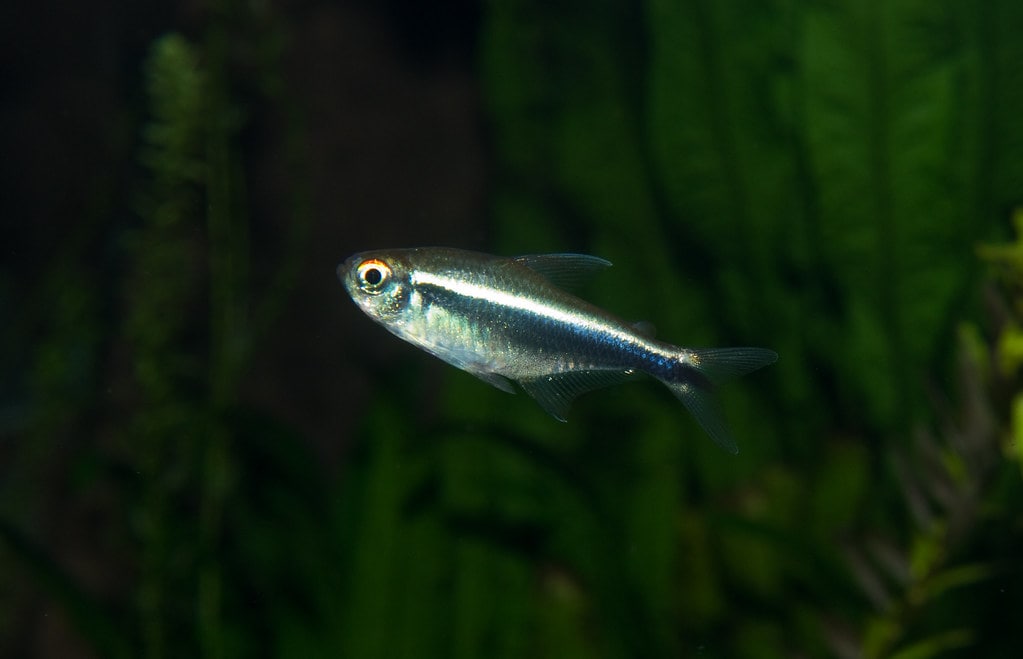
The Black Neon Tetras (Hyphessobrycon herbertaxelrodi) are very identical as the neon tetras but are of different species. They have the same body shape and marking in their body. However, the coloration of the black neon tetra is different from the neon tetra. As the name suggests it has a streak of black and silver lining across its body form the tip of the mouth to the tail. If you are tired of keeping neon tetras but want similar fish, the black neon tetras are perfect for you.
Fish Classification
| Category | Rating |
|---|---|
| Scientific Name | Hyphessobrycon herbertaxelrodi |
| Common Names | Black Neon Tetra, Black Neons |
| Origin / Habitat | South America, Brazil |
| Family | Characidae |
| Color Form | As the name suggests, it has a streak of black and silver lining across its body form the tip of the mouth to the tail. |
| Adult Size | 1.5 inches (3-4 cm) |
| Lifespan | 3 - 5 years |
| Fish Behavior/Temperament | Very peaceful; best kept in a small school (shoal) of at least six or more. |
| Water Temperature | 71°F - 80°F (21°C - 27°C) |
| Water Hardness | 6° to 12° dH |
| Water pH | 5.5 - 7.0 |
| Water Movement | They enjoy the steady current and use them like a treadmill to play. Please don't make the water movement too much to make them continuously swim against. |
| Lightings | Requires the lights to be on at least 9-12 hours a day. For ease by a mechanical/automatic timer switch to remove the manual on-off of lights. |
| Tank Region | Middle to bottom |
| Tankmates | They are very peaceful and are not big in size too. Keep them in a small school as they are schooling fish. Don't keep them with larger fish. Since they are small in size, large fish can try to eat them:- e.g., Angelfish. |
| Diet and Food | Omnivore; They accept a varied diet with live food, frozen food, and they should accept flake food. |
| Gender Difference | Can be difficult to determine, F |
| Breeding Difficulties | They are difficult to breed however have been bred in captivity and are egg layers. |
| Tank Setup | Freshwater[Planted] |
| Disease | Tumors, Hemorrhagic Septicemia, White Spot Disease or ICH, Eye-Cloud / Cloudy Eyes, Gill Parasites, Anchor Worm, Furunculosis, Swim Bladder Disorder, etc. Learn more about:- Tetra Fish Disease and Treatment. |
| Aquarium Size | 20-gallon minimum (schooling fish) |
7. Black Phantom Tetra
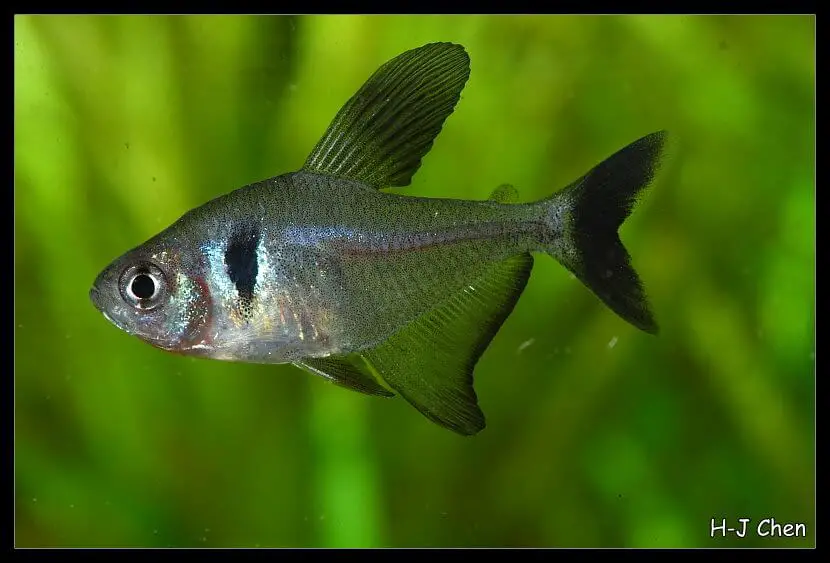
The Black Phantom Tetra (Hyphessobrycon megalopterus) are some of the most common tetra fish in the fishkeeping hobby. We also know the Black phantom tetras as phantom tetras. They are small tetra fish belonging to Characin family. They have long dorsal and anal fins and have a black spot behind their gills similar to the bleeding heart tetras but black.
Fish Classification
| Category | Rating |
|---|---|
| Scientific Name | Hyphessobrycon megalopterus |
| Common Names | Phantom Tetra |
| Origin / Habitat | Originated from South America:- from different south American river basin |
| Family | Characidae |
| Color Form | The body shape is roughly tetragonal. The dominant color is light grey with black patches and silver edging around gills. |
| Adult Size | Up to 2 inches (5 cm) |
| Lifespan | 3 - 5 years, perhaps longer |
| Fish Behavior/Temperament | This is a generally peaceful fish and does well when kept in a small school of 6 or more. However, the males may become aggressive with other male black phantom tetras around spawning time. |
| Water Temperature | 72°F - 80°F (22°C - 28°C) |
| Water Hardness | 4° to 11° dH |
| Water pH | 6 - 7.5 |
| Water Movement | Keep the water movement moderate. You can tell current is too much if you see your fish laying flat against the aquarium glass. |
| Lightings | Requires the lights to be on at least 11-13 hours a day. For ease by a mechanical/automatic timer switch to remove the manual on-off of lights. |
| Tank Region | Middle to bottom |
| Tankmates | Similar or smaller sized species (tetras, rasboras) that are comparable in temperament. It does well with other tetras. |
| Diet and Food | Omnivorous. In the wild, they eat small insects.On aquarium, you can provide high-quality food flake food as the main diet. Sometimes Treat them with high protein food like such as blood worms and brine shrimp. |
| Gender Difference | Females look more full-bodied (eggs), and the Malemale may become darker colored when ready to breed. Fins of males are black, while female fins are redder in color. |
| Breeding Difficulties | Difficult. They need a separate breeding tank. Don't put substrate on that tank as they are egg scatterers.Tank Condition:- High-quality foods, lower the light levels, and drop the pH slightly. |
| Tank Setup | Freshwater[Planted] |
| Disease | White Spot Disease or ICH, Pop-Eye, Gill Parasites, Hemorrhagic Septicemia, Tumors, Mouth Fungus, Anchor Worm, Eye-Cloud / Cloudy Eyes, etc. Learn more about:- Tetra Fish Disease and Treatment. |
| Aquarium Size | 10-gallon minimum |
8. Black Widow Tetra
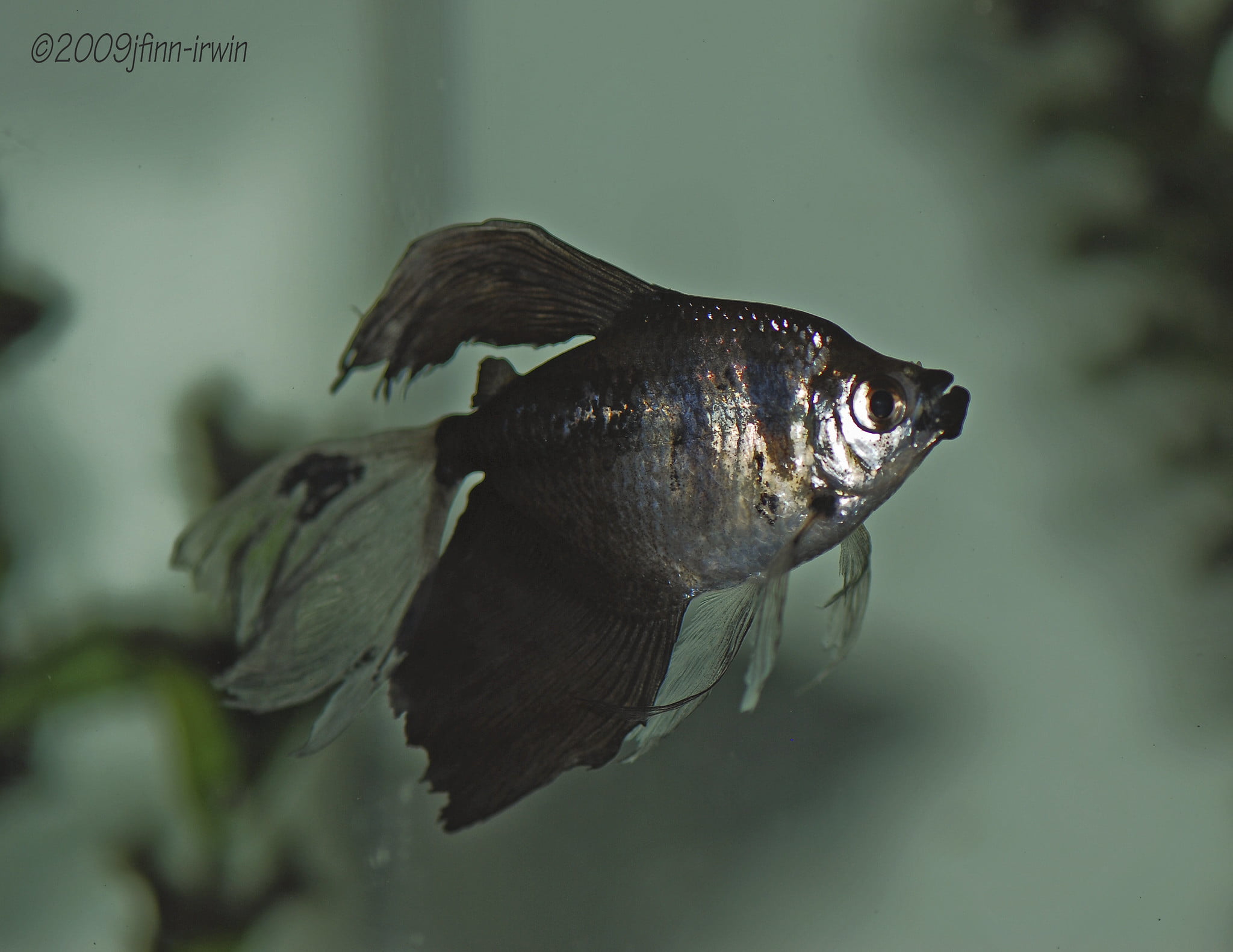
The Black Widow Tetras (Gymnocorymbus ternetzi) is one of the most commonly kept tetra fish in the hobby. These fish are native to Sothern America. The black widow tetras are extremely hardy and easy to keep. The anal fin of the black widow tetra is black in color which is different from the grey color in the body and for this reason the black widow tetras are also known as black skirt tetra or simply black tetra.
Fish Classification
| Category | Rating |
|---|---|
| Scientific Name | Gymnocorymbus ternetzi |
| Common Names | Black Tetra, Black Widow Tetra |
| Origin / Habitat | South America, river basin areas |
| Family | Characidae |
| Color Form | The anal fin of the black widow tetra is black, which is different from the grey color in the body. |
| Adult Size | 2 inches (6 cm) |
| Lifespan | 3 - 5 years |
| Fish Behavior/Temperament | They are generally peaceful little tetra that needs to be in a school of 5 or more. |
| Water Temperature | 75°F - 80°F (24°C - 27°C) |
| Water Hardness | 5° to 20° dH |
| Water pH | 6 - 7.5 |
| Water Movement | It prefers a steady current but not too strong. If the water current is too much, it will lead to stress. |
| Lightings | Requires the lights to be on at least 9-10 hours a day. Light will aid them in maintaining their circadian rhythm. |
| Tank Region | Every level. But they mostly reside in the middle and top areas. |
| Tankmates | Don't keep them with overly aggressive tank mates. They are Fin nippers. Don't put it with:- Angelfish and Bettas. Better not to mix with other tetras too. |
| Diet and Food | The Black Skirt should eat the most common aquarium foods. Flakes, frozen, freeze-dried, and may nibble at some aquarium plants. |
| Gender Difference | The female will usually be larger, and the Malemale may have a wider anal fin. |
| Breeding Difficulties | Egg scatterer. Adults trends to eat the eggs. You will need a bare bottom breeding tank. Remove the adults after they release the eggs. |
| Tank Setup | Freshwater[Planted] |
| Disease | Slime Disease, Eye-Cloud / Cloudy Eyes, Tumors, Dropsy, Hole In The Head, Columnaris, Furunculosis, Pop-Eye, etc. Learn more about:- Tetra Fish Disease and Treatment. |
| Aquarium Size | 20-Gallons (114 liters) - good to keep it in groups of 5 or more. |
9. Black Morpho Tetra
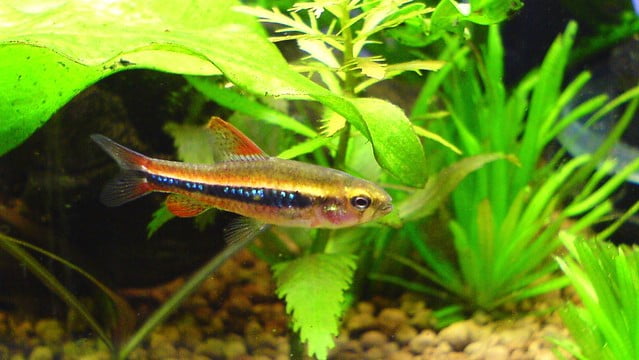
The Black Morpho Tetras (Poecilocharax weitzmani) are some of the most interesting looking tetra fish. We also know the Black Morpho tetras as black darter tetra. The fish originates from the Amazon basin of Peru, Venezuela, and Cambodia. The Black Morpho tetras have large and beautiful fins and their body closely resembles a dart. These fish aren’t for everyone and might be hard to care for. So you must do some research before buying your first pair of Black Morpho Tetra. You will need at least a 30-gallon aquarium tank to keep a pair of black Morpho tetra.
Fish Classification
| Category | Rating |
|---|---|
| Scientific Name | Poecilocharax weitzmani |
| Common Names | Black Morpho Tetra or Black Darter Tetra |
| Origin / Habitat | The fish originates from the Amazon basin of Peru, Venezuela, and Cambodia. |
| Family | Characidae |
| Color Form | The Black Morpho tetras have large and beautiful fins, and their body closely resembles a dart. |
| Adult Size | Average 1.5 to 2 inches (4-5 cm) |
| Lifespan | 5 - 6 years |
| Fish Behavior/Temperament | Generally peaceful, but males will spar with one another. May chase very small fish. |
| Water Temperature | 76°F - 82°F (24°C - 28°C) |
| Water Hardness | 3° to 7° dH |
| Water pH | 6.5 - 7.2 |
| Water Movement | Keep the water movement moderate. You can tell current is too much if you see your fish laying flat against the aquarium glass. |
| Lightings | Requires the lights to be on at least 8-10 hours a day. They prefer dim lighting conditions. It can be achieved with surface vegetation(will diffuse artificial lights). |
| Tank Region | Middle to bottom |
| Tankmates | Similar or smaller sized species (tetras, rasboras) that are comparable in temperament. It does well with other tetras. |
| Diet and Food | Omnivore and micro-predator; will accept almost all frozen and prepared foods |
| Gender Difference | Males are considerably more colorful than females. Females on the other hand are slightly larger and developed extended dorsal and anal fins as they mature, to a spectacular extent in some individuals. |
| Breeding Difficulties | Not often bred in captivity but certainly possible. Arrange the aquarium parameter and feed a diet rich in small live foods to bring the fish into spawning condition. |
| Tank Setup | Freshwater[Planted] |
| Disease | White Spot Disease or ICH, Pop-Eye, Gill Parasites, Hemorrhagic Septicemia, Tumors, Mouth Fungus, Anchor Worm, Eye-Cloud / Cloudy Eyes, etc. Learn more about:- Tetra Fish Disease and Treatment. |
| Aquarium Size | 20-25 gallon |
10. Bleeding Heart tetra
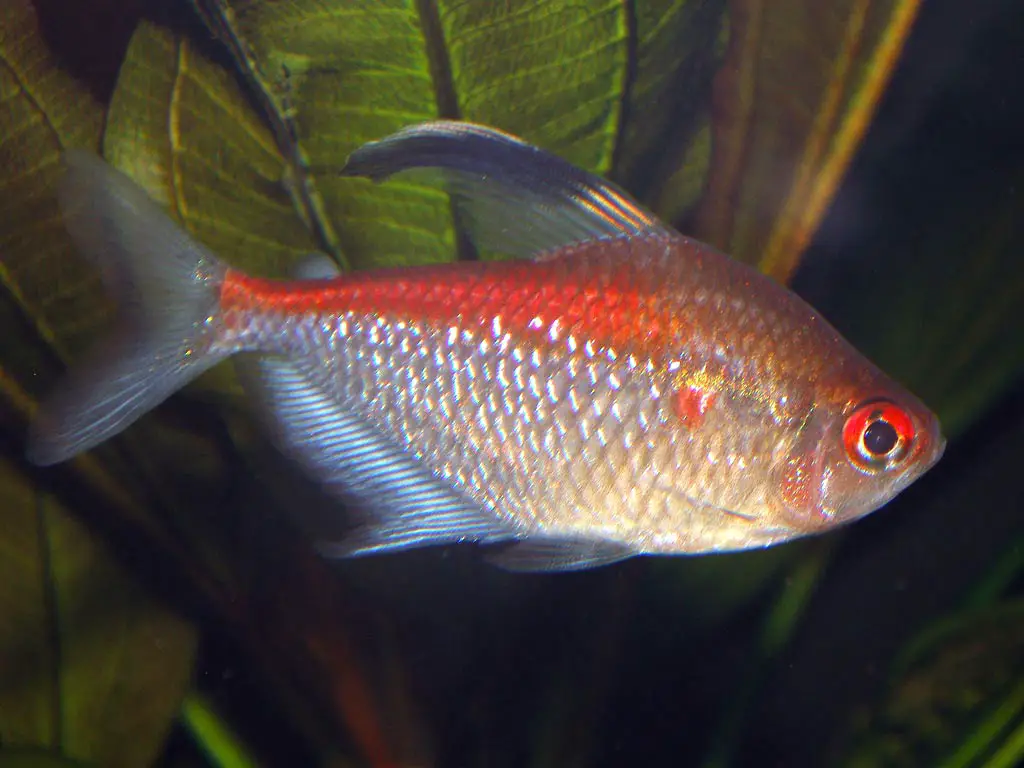
The Bleeding Heart tetras (Hyphessobrycon erythrostigma) are some of the most unique looking tetra fish. The Bleeding heart tetras are native to Upper Amazon river basins. It has a red dot on its body which makes the fish appear like a bleeding heart, thus it is known as Bleeding heart disease. The bleeding heart tetras are some of the most unique looking tetra fish.
Fish Classification
| Category | Rating |
|---|---|
| Scientific Name | Hyphessobrycon erythrostigma |
| Common Names | Bleeding Heart Tetra, Punto Rojo, Red Tipped Tetra |
| Origin / Habitat | South America, Columbia |
| Family | Characidae |
| Color Form | It has a red dot on its body, which makes the fish appear like a bleeding heart. Thus it is known as Bleeding heart disease. |
| Adult Size | 3 inches (8 cm) |
| Lifespan | 3 - 5 years |
| Fish Behavior/Temperament | Peaceful and active |
| Water Temperature | 72°F - 80°F (22°C - 27°C) |
| Water Hardness | 4° to 11° dH |
| Water pH | 6.5 - 7.0 |
| Water Movement | It prefers a steady current but not too strong. You can tell current is too much if you see your fish laying flat against the aquarium glass. |
| Lightings | Requires the lights to be on at least 11-14 hours a day. For ease by a mechanical/automatic timer switch to remove the manual on-off of lights. |
| Tank Region | Middle to bottom |
| Tankmates | Keep them with similar-sized active fish as they tend to be fin nippers. Also, don't keep them with fish like betas and angelfish. |
| Diet and Food | Omnivore; accepts any form of food like live food, frozen food, flake food, and pellets. |
| Gender Difference | Female is more full-bodied, and the Malemale has a larger dorsal fin |
| Breeding Difficulties | Moderate to Difficult, however, have been bred in captivity and are egg layers. |
| Tank Setup | Freshwater[Planted] |
| Disease | Furunculosis, Anchor Worm, Tumors, Gill Parasites, Slime Disease, Fish Lice, Hemorrhagic Septicemia, Ammonia Poisoning, etc. Learn more about:- Tetra Fish Disease and Treatment. |
| Aquarium Size | 20-gallon minimum |
11. Blood-fin Tetra
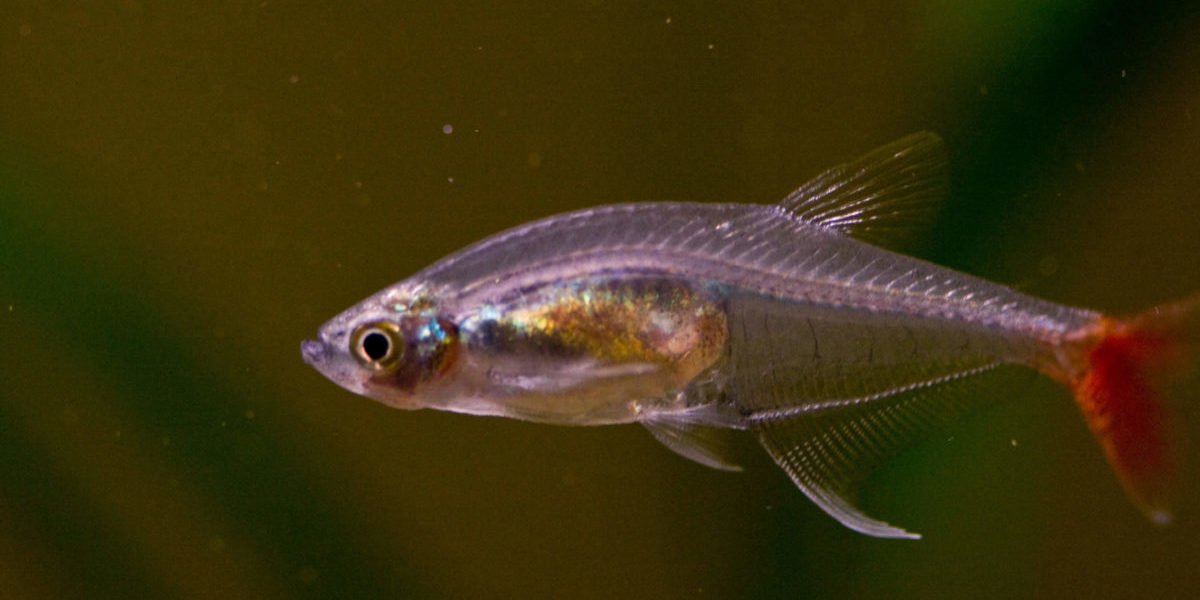
The Blood-fin Tetra, also known as Bloodfin, Glass Bloodfin, the Red-finned Characin, the Red-finned Tetra, and the Argentine Bloodfin, originates from the Rio Parana basin in Argentina, Brazil, and Paraguay, South America.
Blood-fin tetra is silver in color and has a slim and laterally compressed body with forked caudal fin. The caudal, dorsal, anal, and adipose fins are red in color. Among the aquarium, the Bloodfin Tetra is an excellent freshwater ray-finned fish.
The maximum size of blood-fin tetra is 5-5.5 cm (2 inches). Red bloodfin tetra lives about 4-6 years. The anal fin has a small hook at the end of the male.
The fish jumps above the water surface and leaves its eggs in the water. During the time of spawning, due to the heavyweight of the eggs, falls to the floor of the tank or water body — the female deposits 300–500 eggs at a time.
Since bloodfin tetra is a very enduring and undemanding fish, it is suitable for beginning aquarists.
For the fish couple, it requires the minimum tank size of 30 liters, but it would be better to keep them in a school in a large-sized tank. Bloodfin tetra should be about 6-8 species in a tank of school. Since the fish swims in the upper water layer and they are capable of jumping out from the tank, the tank should be an elongated one and covered from the top. The water temperature of the tank should be 72- 82 F.
Bloodfin Tetra feeds the live blood worms, glass worms, brine shrimp, and tubifex worms. Bloodfin Tetra also feeds the frozen vegetable diet, daphnia, plankton, beef heart, flakes, and frozen, dried foods too.
Fish Classification
| Category | Rating |
|---|---|
| Scientific Name | Aphyocharax anisitsi |
| Common Names | True Bloodfin, Glass Bloodfin, Red Finned Tetra |
| Origin / Habitat | South America river basins |
| Family | Characidae |
| Color Form | Blood-fin tetra is silver in color and has a slim and laterally compressed body with forked caudal fin. The caudal, dorsal, anal, and adipose fins are red in color. |
| Adult Size | up to 2 inches (5 cm) |
| Lifespan | 6 to 9 years |
| Fish Behavior/Temperament | Fin nippers if kept alone. So, keep them in a school of at least 6 but watch closely for minor fin nipping. |
| Water Temperature | 70°F - 80°F (21°C - 27°C) |
| Water Hardness | 5° to 10° dH |
| Water pH | 6 - 8 |
| Water Movement | Keep the water movement moderate. If there are areas on the aquarium for them to rest against the current, they love the flow. |
| Lightings | Requires the lights to be on at least 10-12 hours a day. The light watt will depend on factors like aquarium size, amount of substrate, the density of plants. |
| Tank Region | Middle to Top |
| Tankmates | A peaceful fish that's best kept in a small school. |
| Diet and Food | Omnivore; accepts any form of food like live food, frozen food, flake food, and pellets. |
| Gender Difference | It can be hard to determine; females may be more full-bodied and have less red on the fins. Males are usually streamlined with more red on the fins. |
| Breeding Difficulties | Egg layers, challenging to breed. |
| Tank Setup | Freshwater[Planted] |
| Disease | Columnaris, Dropsy, Eye-Cloud / Cloudy Eyes, Gill Parasites, Anchor Worm, Ammonia Poisoning, White Spot Disease or ICH, Fish Lice, etc. Learn more about:- Tetra Fish Disease and Treatment. |
| Aquarium Size | 20-gallon minimum (keep in small schools) |
12. Blue Tetra
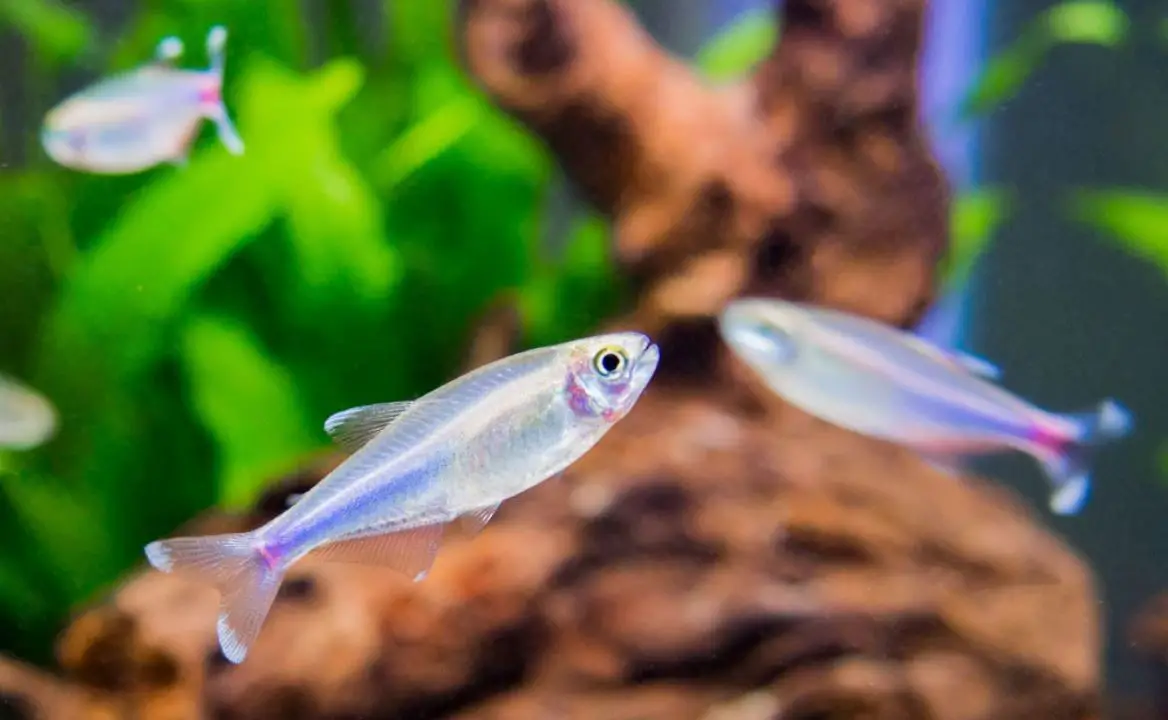
The Blue Tetra (Knodus borki) is a small variety of tetra fish native to the rivers, and streams of Brazil and Colombia. These fish are very small in size and only grow to about 5cm in length. The female blue tetra tends to be larger than the male however, they don’t exceed 8cm in length. Their compact size makes them perfect for a planted tank. The abdominal part of the Blue Tetra is shining silver in color and the tail part is blue in color. This color combination makes it a gem to the eye. You can easily house a school of Blue tetra in a small aquarium as small as 10gallon.
Fish Classification
| Category | Rating |
|---|---|
| Scientific Name | Knodus borki |
| Common Names | Blue Tetra |
| Origin / Habitat | Colombia and Brazil. In wild, found in Rivers, streams, and tributaries. |
| Family | Characidae |
| Color Form | The abdominal part of the Blue Tetra is shining silver in color, and the tail part is blue in color. This color combination makes it a gem to the eye. |
| Adult Size | 2 inches (5 cm) |
| Lifespan | 2 to 4 years |
| Fish Behavior/Temperament | Although generally peaceful, it may occasionally nip the fins of conspecifics and other species with elongated fins |
| Water Temperature | 72-78°F (22-26°C) |
| Water Hardness | 5-12 |
| Water pH | 5.5 - 7.0 |
| Water Movement | It prefers a steady current but not too strong. If there are areas on the aquarium for them to rest against the current, they love the flow. |
| Lightings | Requires the lights to be on at least 8-11 hours a day. Light will aid them in maintaining their circadian rhythm. |
| Tank Region | all over the tank |
| Tankmates | To limit fin nipping behaviour, keep them in groups of 5 or more. Also don't keep them with larger fish. |
| Diet and Food | Omnivorous. Blue tetras will greedily accept flake food, suitably sized granular food, frozen food like daphnia, cyclops, and blood worms. |
| Gender Difference | Mature females have a round belly. Males are a little more intensely colored than females, and their anal fin tends to become suffused with a reddish color when in spawning condition. |
| Breeding Difficulties | Difficult to breed in captivity. As eggs need slightly acidic conditions for better hatch rates. |
| Tank Setup | Freshwater[Planted] |
| Disease | White Spot Disease or ICH, Anchor Worm, Mouth Fungus, Hole In The Head, Fish Fungus / Fungal Infection, Tumors, Pop-Eye, Eye-Cloud / Cloudy Eyes, etc. Learn more about:- Tetra Fish Disease and Treatment. |
| Aquarium Size | 20 to 30 gallon recommended (schooling fish) |
13. Buck Tooth Tetra
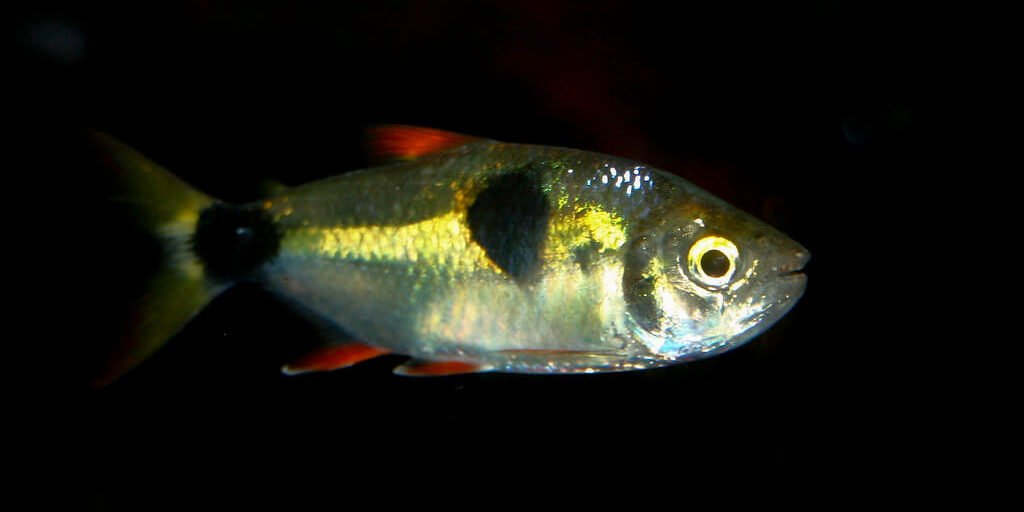
The Buck Tooth Tetra (Exodon paradoxus) is one of the aggressive variety of tetra fish. They are carnivorous and are micro predators. The bucktooth tetra originates from the Amazon basin. It was first discovered in 1932 in the aquarium hobby. We can see a lot of small sharp teeth in the mouth of the bucktooth tetra. It has a silver body with a distinct black batch on its body and the tail.
Fish Classification
| Category | Rating |
|---|---|
| Scientific Name | Exodon paradoxus |
| Common Names | Bucktooth Tetra |
| Origin / Habitat | South America, Amazon and Tocantins River basins. |
| Family | Characidae |
| Color Form | It has a silver body with a distinct black batch on its body and the tail. |
| Adult Size | 2.9 inches (7.5 cm) |
| Lifespan | 8 to 10 years |
| Fish Behavior/Temperament | Aggressive; they need a species only tank due to them being lepidophages (eats the scales off of other fish). |
| Water Temperature | 73°F - 82°F (23°C - 28°C) |
| Water Hardness | 5-20 |
| Water pH | Water parameters: 5.5 - 7.5 |
| Water Movement | It prefers a steady current but not too strong. Please don't make the water movement too much to make them continuously swim against. |
| Lightings | Requires the lights to be on at least 8-11 hours a day. The light watt will depend on factors like aquarium size, amount of substrate, the density of plants. |
| Tank Region | all over the tank |
| Tankmates | Best kept in a species tank to avoid aggressiveness. It should be ok if keeping them with scaleless catfish species. |
| Diet and Food | Fish scales, small insects, good pellet food or flake food a twice a day. |
| Gender Difference | Don't know of any ways to tell males from females by external characteristics. |
| Breeding Difficulties | Egg scatterers |
| Tank Setup | Freshwater[Planted] |
| Disease | Fish Fungus / Fungal Infection, Mouth Fungus, Eye-Cloud / Cloudy Eyes, Hemorrhagic Septicemia, Ammonia Poisoning, Hole In The Head, Columnaris, Fin and Tail Rot, etc. Learn more about:- Tetra Fish Disease and Treatment. |
| Aquarium Size | 30 gallon recommended (schooling fish) |
14. Buenos Aires Tetras
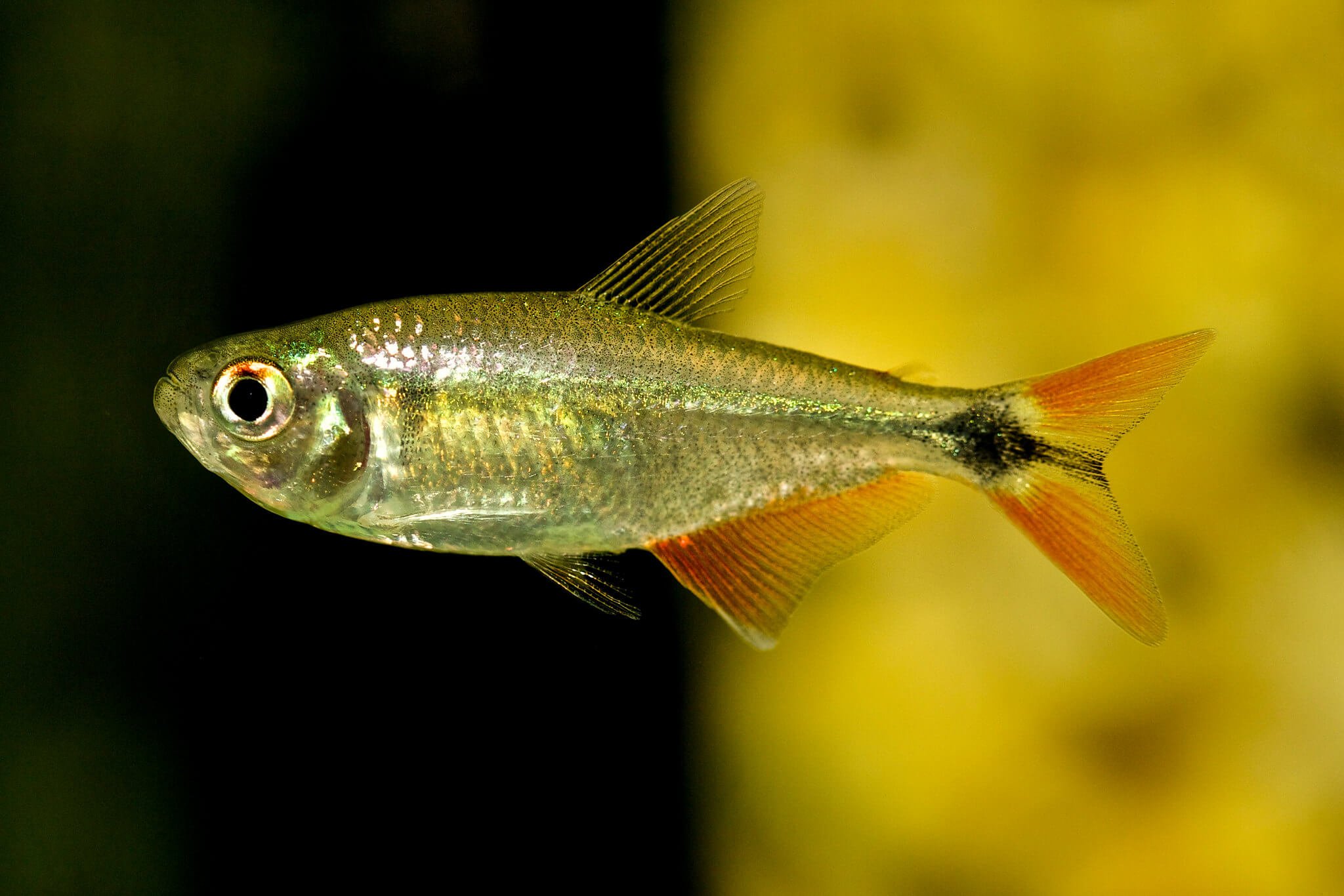
Buenos Aires Tetras scientifically known as “Hyphessobrycon Anisitsi,” also known as “Hemigrammus Anisitsi,” “Hemigrammus caudovittatus,” and “Hyphessobrycon erythrurus” and commonly called “Buenos Aires tetra,” “diamond spot characin,” “red cross fish.” The fish has a pretty, silvery color overall, with some flashy neon highlights and is hardy, long-lived, and prolific breeders.
These full-bodied fish can be up to about 2.75inches (7 cm) in length and can survive about 5 to 6 years. The most distinguishing feature of Buenos Aires tetra is the bold, black ‘cross’ shaped pattern at the base of its tail fin, accented with red above and below. Male Buenos Aires tetras have brighter, red fins and are generally more colorful overall, particularly during spawning, whereas females are larger and broader with a rounder belly. They usually spawn at dawn. When a female is full of eggs, the belly will become nicely rounded. Females may lay as many as 2,000 eggs, depositing them on the plants or green floss.
It is originated from Argentina, southeastern Brazil, and Paraguay. The aquarium size is about 30 gallons slightly acidic to neutral with a pH of 5.8 to 8.5 and a temperature of 64 to 820F. Gentle filtration, like a sponge filter, is recommended. If the tank is densely stocked, you need to replace at least 25 to 50 percent of the tank water every other week.
Buenos Aires tetras should be fed several times a day. Buenos Aires tetra is omnivores and accepts a wide variety of foods. In the wild, these tetras primarily feed on worms, crustaceans, insects, and plants. However, in the aquarium, they are fed all kinds of live food, fresh, and flake foods, lettuce, spinach, or other vegetation. Offering live foods such as bloodworms, daphnia, brine shrimp, and mosquito larvae can keep these tetras at their best and most colorful.
Fish Classification
| Category | Rating |
|---|---|
| Scientific Name | Hyphessobrycon anisitsi |
| Common Names | Diamond Spot Tetra |
| Origin / Habitat | It is originated from Argentina, southeastern Brazil, and Paraguay. |
| Family | Characidae |
| Color Form | This fish has a pretty, silvery color overall, with some flashy neon highlights and is hardy, long-lived, and prolific breeders. |
| Adult Size | 3 inches (8 cm) |
| Lifespan | 3 - 5 years or longer |
| Fish Behavior/Temperament | It can be fin nippers and best kept in a small school (shoal) of 6 or more. |
| Water Temperature | 72°F - 80°F (22°C - 27°C) |
| Water Hardness | 4° to 11° dH |
| Water pH | 5.5 - 7.0 |
| Water Movement | They enjoy the steady current and use them like a treadmill to play. If there are areas on the aquarium for them to rest against the current, they love the flow. |
| Lightings | Requires the lights to be on at least 10-12 hours a day. The light watt will depend on factors like aquarium size, amount of substrate, the density of plants. |
| Tank Region | Middle to bottom |
| Tankmates | Keep them with semi aggressive fish or fish that doesnot have long fins. |
| Diet and Food | Omnivorous. Its diet includes small pellets and flakes. You can feed them live/frozen food such as daphnia, brine shrimp, etc. |
| Gender Difference | Difficult to determine. |
| Breeding Difficulties | Moderate to Difficultl They have been bred in captivity and are egg layers. |
| Tank Setup | Freshwater[Planted] |
| Disease | Mouth Fungus, Anchor Worm, Velvet, Swim Bladder Disorder, Columnaris, Hole In The Head, Hemorrhagic Septicemia, Tumors, etc. Learn more about:- Tetra Fish Disease and Treatment. |
| Aquarium Size | 20-gallon minimum (schooling fish) |
15. Candy Cane Tetra

The Candy Cane Tetra (Hyphessobrycon bentosi) is one of the most beautiful tetra fish. It is also known as the Ornate tetra and False Rosy tetra due to its close resemblance. The Candy Cane Tetra is native to Southern America. What differentiation the candy cane tetra from the rosy tetra is its beautifully dorsal and anal fin. These fins are usually long and white-colored. The gown to about 5cm long which is almost the same as the Rosy tetra. The candy cane Tetra makes a perfect fish for your community tank or a planted tank. It is considered to be one of the premium tetra fish.
Fish Classification
| Category | Rating |
|---|---|
| Scientific Name | Hyphessobrycon Bentosi |
| Common Names | Candy Cane Tetra, Ornate Tetra |
| Origin / Habitat | It is native to the Amazon basin in Peru. |
| Family | Characidae |
| Color Form | You can identify this Tetra from its translucent pink-colored flat body with darker red marked fins. |
| Adult Size | 3 inches (8 cm) |
| Lifespan | 3 - 5 years or longer |
| Fish Behavior/Temperament | Candy Cane Tetra is a peaceful shoaling species of Tetra. Their non-aggressive nature is what makes them the right choice for community fish. |
| Water Temperature | 73° – 82° F (22.7° – 28° C) |
| Water Hardness | 3° to 12° dGH |
| Water pH | 6.0-7.2, slightly acidic water |
| Water Movement | They enjoy the steady current and use them like a treadmill to play. If there are areas on the aquarium for them to rest against the current, they love the flow. |
| Lightings | A low output LED light is the best lighting environment. For a balanced ecosystem, consider adding plants as well as hiding spots for the fish. |
| Tank Region | Middle to bottom |
| Tankmates | Candy Cane Tetras go along well with other Tetra and smaller rasboras, barbs, Anabantoids, angelfish, Discus, Apistogramma dwarf cichlids, Corydoras, small Loricariids, and other Hyphessobrycon or Hemigrammus species. Diamond Tetra, Bleeding Heart Tetra, Black Phantom Tetra, or the Kuhli Loach are also good Tankmates. |
| Diet and Food | they are omnivorous. They generally eat all kinds of living, fresh, and flake foods. |
| Gender Difference | Male Candy Cane Tetras are more colorful than females and have a more elongated dorsal fin than females. |
| Breeding Difficulties | Breeding fish in an aquarium requires the focus on key factors like lighting, setting, plants, temperature, pairing, pH level, and the diet. |
| Tank Setup | Freshwater[Planted] |
| Disease | Mouth Fungus, Anchor Worm, Velvet, Swim Bladder Disorder, Columnaris, Hole In The Head, Hemorrhagic Septicemia, Tumors, etc. Learn more about:- Tetra Fish Disease and Treatment. |
| Aquarium Size | 20-gallon minimum (schooling fish) |
16. Cardinal tetra
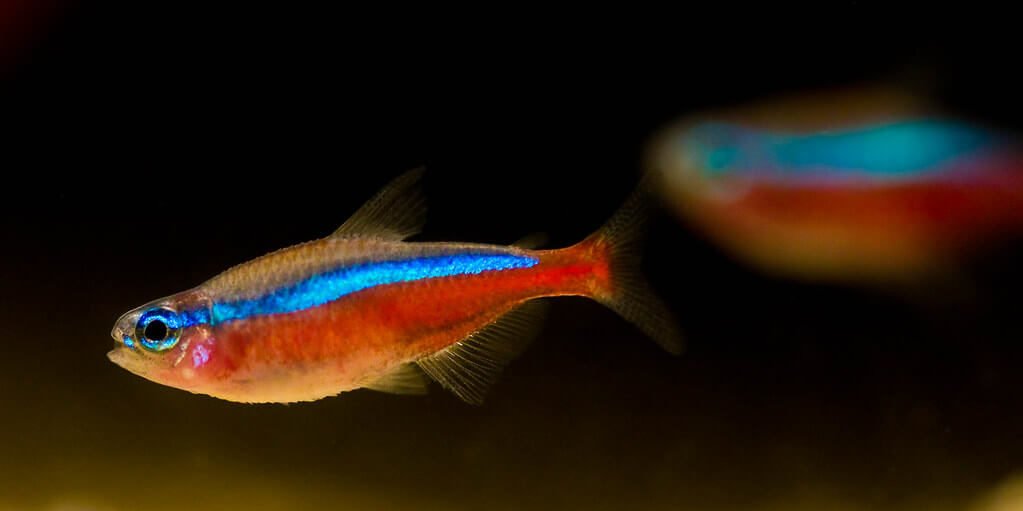
The Cardinal tetras (Paracheriodon axelrodi) are some of the larger sized tetra fish. The cardinal tetra originates from Southern America and closely resembles the neon tetra in coloration. Cardinal tetras are the buffed up version of neon tetras. They look beautiful in a large planted tank as it gains a lot of attention for its bright color and its size. The cardinal tetras can grow to up to 3 inches.
Fish Classification
| Category | Rating |
|---|---|
| Scientific Name | Paracheirodon axelrodi |
| Common Names | Cardinal Tetra |
| Origin / Habitat | South America |
| Family | Characidae |
| Color Form | Closely resembles the neon tetra in coloration. These fish have a bright streak of red coloration towards its tail and a bright blue lining in its body. |
| Adult Size | Up to 2 inches (5 cm) |
| Lifespan | 2 - 5 years |
| Fish Behavior/Temperament | Peaceful temperament; best kept in schools of 6 or more. |
| Water Temperature | 73°F - 80°F (23°C - 27°C) |
| Water Hardness | 2° to 6° dH |
| Water pH | 5.5 - 7, (preferred: water slightly acidic) |
| Water Movement | They enjoy the steady current and use them like a treadmill to play. If there are areas on the aquarium for them to rest against the current, they love the flow. |
| Lightings | Requires the lights to be on at least 8-9 hours a day. Light will aid them in maintaining their circadian rhythm. |
| Tank Region | Mostly middle to the top. |
| Tankmates | Keep them with similar-sized peaceful fish. |
| Diet and Food | Will go after flakes, live and freeze-dried foods. Give them a varied diet for the best results. |
| Gender Difference | Females' belly looks slightly fuller than males. |
| Breeding Difficulties | They can be challenging to breed in the home aquarium. |
| Tank Setup | Freshwater[Planted] |
| Disease | Swim Bladder Disorder, Pop-Eye, Eye-Cloud / Cloudy Eyes, Dropsy, Mouth Fungus, Ammonia Poisoning, Gill Parasites, Velvet, etc. Learn more about:- Tetra Fish Disease and Treatment. |
| Aquarium Size | 10 gallons or larger. |
17. Carlana Tetra
The Carlana tetra (Caralana egeinmanni) is a rare variety of tetra fish that has a unique appearance. The Carlana tetra originates from the freshwater of Costa Rica and Panama. It has a pale yellow body and a distinctive long dorsal fin. The body color and its fin gives the fish quite a unique appearance. Carlana tetras grow up to 7 cm. These fish are very sensitive to changes in the parameter of the water in your aquarium. I would only suggest expert level fish keepers keep Carlana Tetras in their aquarium.
Fish Classification
| Category | Rating |
|---|---|
| Scientific Name | Caralana egeinmanni |
| Common Names | Carlana Tetra |
| Origin / Habitat | The Carlana tetra originates from the freshwater of Costa Rica and Panama. |
| Family | Characidae |
| Color Form | It has a pale yellow body and a distinctive long dorsal fin. The body color and its fin gives the fish quite a unique appearance. |
| Adult Size | average 2.5 inches (6 cm) |
| Lifespan | 8 to 10 years, likely longer |
| Fish Behavior/Temperament | Community and peaceful fish |
| Water Temperature | 73°F - 82°F (23°C - 28°C) |
| Water Hardness | 6° to 10° dH |
| Water pH | 6 - 7 |
| Water Movement | It prefers a steady current but not too strong. You can tell current is too much if you see your fish laying flat against the aquarium glass. |
| Lightings | Requires the lights to be on at least 9-10 hours a day. The light watt will depend on factors like aquarium size, amount of substrate, the density of plants. It doesn't require bright light. |
| Tank Region | Middle to lower levels. |
| Tankmates | Similar sized fish like rasboras, barbs, TetraTetra, Anabantoids, angelfish, Corydoras, etc |
| Diet and Food | Omnivorous, Micropredator |
| Gender Difference | Difficult to differentiate |
| Breeding Difficulties | Open water/substratum egg scatterers. |
| Tank Setup | Freshwater[Planted] |
| Disease | Ammonia Poisoning, Fish Fungus / Fungal Infection, Eye-Cloud / Cloudy Eyes, Tumors, Hemorrhagic Septicemia, Mouth Fungus, Slime Disease, Gill Parasites, etc. Learn more about:- Tetra Fish Disease and Treatment. |
| Aquarium Size | 25 gallon |
18. Cochus Blue Tetra

The Cochus Blue Tetra (Boehlkea fredeouchi) is some of the more common varieties of tetra fish. They are native to the Amazon basin. Their body is entirely painted by blue color sp they are also known as Cochus Blue tetras. The Cochus tetras are fast-swimming fish suitable for planted tanks and any type if community tank.
Fish Classification
| Category | Rating |
|---|---|
| Scientific Name | Boehlkea fredcochui |
| Common Names | Cochu's Blue Tetra |
| Origin / Habitat | South America, Amazon River basins. |
| Family | Characidae |
| Color Form | The abdominal part of the Blue Tetra is shining silver in color, and the tail part is blue in color. This color combination makes it a gem to the eye. |
| Adult Size | 1.6 inches (4.1 cm) |
| Lifespan | 3 to 4 years |
| Fish Behavior/Temperament | Fin nippers |
| Water Temperature | 73°F - 82°F (23°C - 28°C) |
| Water Hardness | 5-12 |
| Water pH | 6 - 8 |
| Water Movement | It prefers a steady current but not too strong. If there are areas on the aquarium for them to rest against the current, they love the flow. |
| Lightings | Requires the lights to be on at least 8-11 hours a day. Light will aid them in maintaining their circadian rhythm. |
| Tank Region | all over the tank |
| Tankmates | Keep them in groups of 5 or more to limit the fin nipping. They should do fine with other species when kept in a small school. You obviously don't want to keep them with fish big enough to eat them. |
| Diet and Food | Give them a high-quality micro pellet type food (like New Life Spectrum pellets) or flakes. You can feed Cochu's Blue Tetra live or frozen(by slightly warming it) freshwater fish food too. |
| Gender Difference | Males will be thinner with bolder colors than females. |
| Breeding Difficulties | Difficult to breed in captivity |
| Tank Setup | Freshwater[Planted] |
| Disease | White Spot Disease or ICH, Anchor Worm, Mouth Fungus, Hole In The Head, Fish Fungus / Fungal Infection, Tumors, Pop-Eye, Eye-Cloud / Cloudy Eyes, etc. Learn more about:- Tetra Fish Disease and Treatment. |
| Aquarium Size | 20 to 30 gallon recommended (schooling fish) |
19. Colombian Tetra
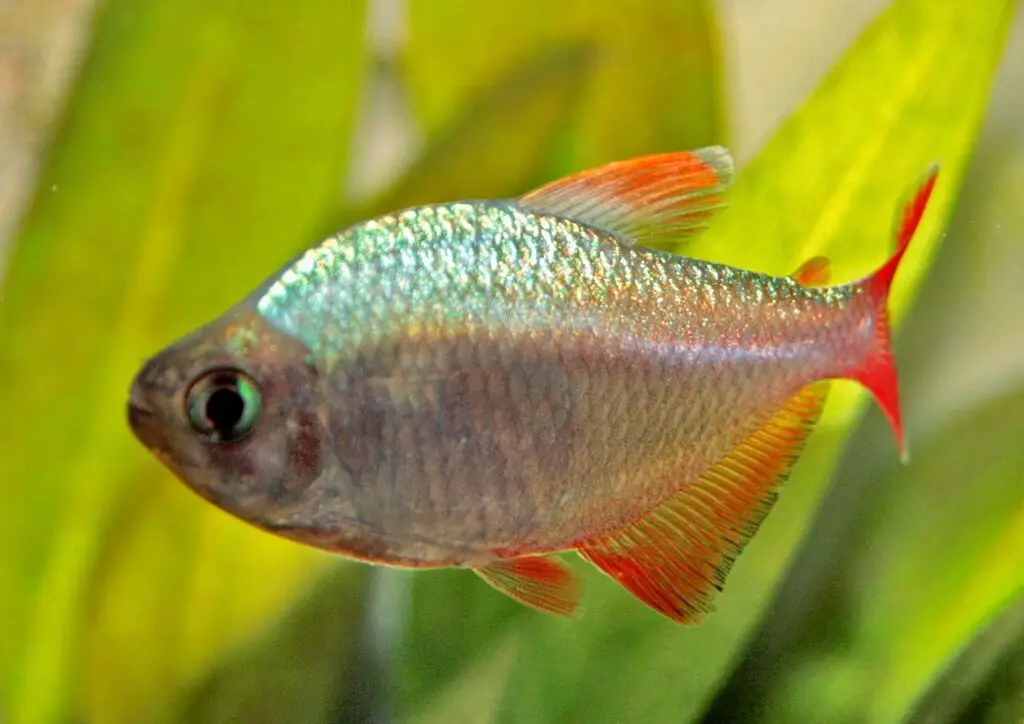
The Colombian Tetra is also known as the “Columbian” Tetra, the Blue-Red Columbian, and the Red Tail Mirror Blue Tetra originated from Colombia. The fish is scientifically known as Hyphessobrycon ecuadoriensis and was recently changed to Hyphessobrycon columbianus, which more accurately describes its Colombian origin.
Talking about its body structure, the caudal fin of the Colombian tetra has a band of blue across the upper body with red in the fins, and the lower body is silvery.
The normal lifespan of Colombian Tetra is about 5 years and grow up to 7 cm or 2.5 inches.
The aquarium size should be with the base dimensions of 90 ∗ 30 cm or equivalent 30 US Gallon. When kept in groups of 6, Colombians are happier and show better colors. They appreciate a well-planted tank, but they will eat plants.
Colombians will eat flake foods, freeze-dried bloodworms, and brine shrimp.
Generally, males and females, Colombians, are difficult to distinguish via color. When laden with eggs, the female is larger and broader. Slightly acidic but soft water is best for breeding with pH 5-7.5 and temperature of 20-28 degree Celcius whereas lighting should be greatly dimmed. Before breeding, pairs should be separated for more than a week and fed a variety of foods. Colombians spawn multiple times over days. The parents should be removed after spawning.
Fish Classification
| Category | Rating |
|---|---|
| Scientific Name | Hyphessobrycon columbianus |
| Common Names | Red and Blue Colombian Tetra, Red Tail Mirror Blue Tetra |
| Origin / Habitat | Colombia, South America |
| Family | Characidae |
| Color Form | They have bright blue colors in their body and distinct red fins, which gives them their name red blue Colombian Tetra. |
| Adult Size | Up to 2 inches (5 cm) |
| Lifespan | 3 - 5 years |
| Fish Behavior/Temperament | Keep them in a small school (shoal) of 6 or more. They can be an aggressive tetra, so avoid keeping them with fish that have larger fins to avoid fin nipping. They may also bully smaller tank mates. |
| Water Temperature | 75°F - 80°F (24°C - 27°C) |
| Water Hardness | 6° to 15° dH |
| Water pH | 6 - 7 |
| Water Movement | It prefers a steady current but not too strong. If there are areas on the aquarium for them to rest against the current, they love the flow. |
| Lightings | Requires the lights to be on at least 11-12 hours a day. For ease by a mechanical/automatic timer switch to remove the manual on-off of lights. |
| Tank Region | Mostly middle and bottom. |
| Tankmates | Similar semi-aggressive tetras and fish that can take fo themselves since this fish can be a bully. |
| Diet and Food | Not picky eaters, they should accept flake, frozen, freeze-dried, and live food. |
| Gender Difference | The Male is somewhat smaller than the female. Meanwhile, the female has a large body. |
| Breeding Difficulties | They can be challenging to breed in the home aquarium. They are egg layers. |
| Tank Setup | Freshwater[Planted] |
| Disease | Anchor Worm, Hole In The Head, Velvet, Hemorrhagic Septicemia, Furunculosis, Eye-Cloud / Cloudy Eyes, Pop-Eye, Fish Fungus / Fungal Infection, etc. Learn more about:- Tetra Fish Disease and Treatment. |
| Aquarium Size | 20 gallons or larger. |
20. Congo Tetra

The Congo Tetra is also known as Phenacogrammus Interruptus, is a species of fish in the African tetra family. Congo Tetra is found in the central Congo River Basin in Africa. It is a large fish for tetra kind in which the male size may be up to 8.5 cm, and the female may be up to 6 cm correspondingly.
The lifespan of Congo tetra is 3 to 5 years. The male fish has long veiled edges on a dorsal, fluke, and anal fins and three-bladed tail with a pronounced middle blade.
The body coloring is opalescent, and the colors vary from tints of blue on its back to red-orange and gold yellow on the fish sides, and again there are bluish colors on the abdomen.
Male fish is larger, brighter colored, and it has larger fins, whereas the female fish is small, significantly less brightly colored, and their abdomen is larger and more rounded. At the age of 8-9 months, the fish becomes reproductive.
A tank size of about 20 gallons capacity is required, but it’s better to be 40 gallons or more. The water temperature of 24-27 C is appropriate for a tetra to survive with a pH of 6.5-7.5.
The fish should also consist of 60% of animal feed (blood worm, tubifex, brine shrimp) and 40% of plant feed (filamentous alga, spinach, feeds containing spirulina).
Tankmates can consist of the majority of small African and South American Characin fishes, live-bearing fishes and barb, Corydoras (like pygmy or panda). It’s more proper to keep Congo tetras in a school of 4-20 species separately from other fishes.
Fish Classification
| Category | Rating |
|---|---|
| Scientific Name | Phenacogrammus interrupts |
| Common Names | Congo River, Zaire in Africa |
| Origin / Habitat | South America, Amazon River basin, Nanay River, upper Orinoco River basin |
| Family | Alestidae |
| Color Form | The body coloring is opalescent, and the colors vary from tints of blue on its back to red-orange and gold yellow on the fish sides, and again there are bluish colors on the abdomen. |
| Adult Size | 3 to 3 ½ inches |
| Lifespan | 3 to 5 years, likely longer |
| Fish Behavior/Temperament | Schooling fish (peaceful and timid) |
| Water Temperature | 75°F - 81°F (24°C - 27°C) |
| Water Hardness | 6° to 10° dH |
| Water pH | 6.6 - 7.5 |
| Water Movement | It prefers a steady current but not too strong. You can tell current is too much if you see your fish laying flat against the aquarium glass. |
| Lightings | Congo tetra does not have specific needs when it comes to lighting. If you are keeping the congo tetra without any live plants, low light is enough. |
| Tank Region | Middle to lower levels. |
| Tankmates | Fish like live-bearers, guppy, swordtail, molly is suitable for congo tetra's tankmates. Avoid keeping them with aggressive fish. |
| Diet and Food | Omnivore; accepts any form of food like live food, frozen food, flake food, and pellets. |
| Gender Difference | Not sure how to tell males from females. |
| Breeding Difficulties | Difficult |
| Tank Setup | Freshwater[Planted] |
| Disease | Ammonia Poisoning, Fish Fungus / Fungal Infection, Eye-Cloud / Cloudy Eyes, Tumors, Hemorrhagic Septicemia, Mouth Fungus, Slime Disease, Gill Parasites, etc. Learn more about:- Tetra Fish Disease and Treatment. |
| Aquarium Size | 20 gallons capacity tank to house only congo tetra, but 40 gallons is ideal |
21. Costello Tetra
The Costello tetra (Hemigrammus hyanuary) is the species of tetra fish native to Brazil and Peru. We also know the Costello tetra as Green Neon. The Costello tetras are very plain and dull in colors. They have grey to white bodies and have a black spot towards its tail.
Fish Classification
| Category | Rating |
|---|---|
| Scientific Name | Hemigrammus hyanuary |
| Common Names | January tetra and green neon[This name used for Paracheirodon Simulans also] |
| Origin / Habitat | Amazon basin and is found in Brazil and Peru |
| Family | Characidae |
| Color Form | The Costello tetras are very plain and dull in colors. They have grey to white bodies and have a black spot towards its tail. |
| Adult Size | up to 1.8 inches (4-5 cm) |
| Lifespan | 2 to 3 years, possibly longer |
| Fish Behavior/Temperament | Peaceful |
| Water Temperature | 73°F - 80°F (23°C - 27°C) |
| Water Hardness | 6° to 12° dH |
| Water pH | 5 - 7 [but not very sensitive to pH change] |
| Water Movement | It prefers a steady current but not too strong. If there are areas on the aquarium for them to rest against the current, they love the flow. |
| Lightings | Requires the lights to be on at least 8-11 hours a day. Light will aid them in maintaining their circadian rhythm. |
| Tank Region | Middle to upper levels. |
| Tankmates | You can keep them with small and peaceful schooling fish similar to their size. |
| Diet and Food | Will accept a micro type pellet food (NLS) or smaller flake foods. Supplement with daphnia, thawed brine shrimp, etc. |
| Gender Difference | Not sure how to tell males from females. |
| Breeding Difficulties | Difficult; Egg-scatterer doesn't take care of it's young. |
| Tank Setup | Freshwater; Looks best in a planted tank with a dark substrate and background. |
| Disease | Slime Disease, Gill Parasites, White Spot Disease or ICH, Fin, and Tail Rot, Velvet, Tumors, Hole In The Head, Anchor Worm, etc. Learn more about:- Tetra Fish Disease and Treatment. |
| Aquarium Size | 15/20 gallon minimum |
21. Dawn Tetra
The Dawn tetras (Aphyocharax paraguayensis) are a small variety of freshwater tetra fish. The Panda tetras are native to Paraguay and Brazil. We also know the dawn tetras as Rio tetra or the panda tetras because of the distinct white and black spots around its tail fin area.
Fish Classification
| Category | Rating |
|---|---|
| Scientific Name | Aphyocharax paraguayensis |
| Common Names | Dawn tetra, panda tetra, Rio Tetra |
| Origin / Habitat | Native to Southern Brazil, Bolivia, and Paraguay |
| Family | Characidae |
| Color Form | Distinct white and black spots around its tail fin area |
| Adult Size | 1.3 inches (3-4 cm) |
| Lifespan | 3 - 5 years |
| Fish Behavior/Temperament | Very peaceful |
| Water Temperature | 66°F - 75°F (19°C - 23°C) |
| Water Hardness | 6° to 12° dH |
| Water pH | 5.5 - 7.0 |
| Water Movement | They enjoy the steady current and use them like a treadmill to play. Please don't make the water movement too much to make them continuously swim against. |
| Lightings | Requires the lights to be on at least 9-12 hours a day. For ease by a mechanical/automatic timer switch to remove the manual on-off of lights. |
| Tank Region | Middle to bottom |
| Tankmates | With other temp-compatible community fish. They may frighten slow-moving or timid species with their active behavior. Comparable to zebra danios. |
| Diet and Food | Unfussy eater; will take most foods. |
| Gender Difference | Females are larger and have a rounded body as compared to males. |
| Breeding Difficulties | Moderate to difficult |
| Tank Setup | Freshwater; Looks best in a planted tank with a dark substrate and background. |
| Disease | Tumors, Hemorrhagic Septicemia, White Spot Disease or ICH, Eye-Cloud / Cloudy Eyes, Gill Parasites, Anchor Worm, Furunculosis, Swim Bladder Disorder, etc. Learn more about:- Tetra Fish Disease and Treatment. |
| Aquarium Size | 20-gallon minimum (schooling fish) |
23. Diamond Tetra

The Diamond tetras (M. pitteri) are bright whitish fish, but they aren’t albino. These fish originate from Venezuela. The diamond tetra shines bright in your aquarium. The color of the body of diamond tetras is bright silver colors resembling a diamond and thus they are known as Diamond Tetra.
Fish Classification
| Category | Rating |
|---|---|
| Scientific Name | Moenkhausia pittieri |
| Common Names | Diamond Characin |
| Origin / Habitat | South America, Lake Valencia basin in Venezuela |
| Family | Characidae |
| Color Form | The diamond tetra shines bright in your aquarium. The color of the body of diamond tetras is bright silver colors resembling a diamond, and thus they are known as Diamond Tetra. |
| Adult Size | 2.3 inches (6 cm) |
| Lifespan | 3 - 5 years |
| Fish Behavior/Temperament | Semi-aggressive; Keep them in groups of 5 or more. |
| Water Temperature | 75°F - 82°F (24°C - 28°C) |
| Water Hardness | 5-12 |
| Water pH | Water parameters: 6 - 7 |
| Water Movement | They enjoy the steady current and use them like a treadmill to play. Please don't make the water movement too much to make them continuously swim against. |
| Lightings | Requires the lights to be on at least 10-12 hours a day. The light watt will depend on factors like aquarium size, amount of substrate, the density of plants. |
| Tank Region | Middle to bottom, a fairly active fish |
| Tankmates | Keep them in groups to limit the fin nipping. Avoid keeping them with fish large enough to eat them. |
| Diet and Food | Omnivore; accepts any form of food like live food, frozen food, flake food, and pellets. |
| Gender Difference | As compared to female, a male Diamond Tetra have much longer dorsal fins. |
| Breeding Difficulties | Moderate. |
| Tank Setup | Freshwater[Planted] |
| Disease | Fin and Tail Rot, Eye-Cloud / Cloudy Eyes, Fish Lice, Anchor Worm, Tumors, Hemorrhagic Septicemia, Slime Disease, White Spot Disease, or ICH, etc. Learn more about:- Tetra Fish Disease and Treatment. |
| Aquarium Size | 20 to 30 gallon recommended (schooling fish) |
24. Discus Tetra
The Discus Tetra (Brachychalcinus orbicularis) is a variety of Tetra fish that closely resembles the body shape of the Discuss Cichlid. However, the discus tetras are not as brightly colored as the Discuss cichlid and are very hardy and less demanding. The discus tetras originate from the rivers and creeks of the Sothern America. These fish are omnivorous and often times might eat your plants, so I wouldn’t recommend you to keep the discus tetra in a planted tank. Discuss tetras are very big in size compared to normal-sized tetras and can grow to about 15cm. the Discus Tetra would look great in a community tank with Angelfish and other similar sized semi-aggressive fish.
Fish Classification
| Category | Rating |
|---|---|
| Scientific Name | Brachychalcinus orbicularis |
| Common Names | Discus tetra, silver dollar tetra |
| Origin / Habitat | Originate from the rivers and creeks of the Sothern America. |
| Family | Characidae |
| Color Form | The Discus Tetra closely resembles the body shape of the Discuss Cichlid. However, the discus tetras are not as brightly colored as the Discuss cichlid and are very hardy and less demanding. |
| Adult Size | 4 inches (10 cm) but can grow up to 6.5 inch |
| Lifespan | 3 - 5 years |
| Fish Behavior/Temperament | Peaceful, and very active |
| Water Temperature | 75°F - 80°F (24°C - 27°C) |
| Water Hardness | 5° to 20° dH |
| Water pH | 6 - 7.5 |
| Water Movement | It prefers a steady current but not too strong. You can tell current is too much if you see your fish laying flat against the aquarium glass. |
| Lightings | Requires the lights to be on at least 10-11 hours a day. For ease by a mechanical/automatic timer switch to remove the manual on-off of lights. |
| Tank Region | All over, but seems to congregate near protected areas towards the bottom of the tank most of the time. |
| Tankmates | Discus Tetra would look great in a community tank with Angelfish and other similar sized semi-aggressive fish. |
| Diet and Food | Omnivore, unfussy about what it eats. |
| Gender Difference | May be able to tell the difference in males and females when the female gets "fatter" or fuller. |
| Breeding Difficulties | Extremely difficult in captivity. |
| Tank Setup | Freshwater tank setup with a dark substrate and background. |
| Disease | Mouth Fungus, Pop-Eye, Slime Disease, Dropsy, Hemorrhagic Septicemia, Tumors, Velvet, Columnaris, etc. Learn more about:- Tetra Fish Disease and Treatment. |
| Aquarium Size | 40 gallons |
25. Disk Tetra
The Disk tetra (Myloplus schomnurgkii) is some of the larger sized tetra fish. The disk tetras are native to Sothern America. We also know the Disk Tetras as Disk Pacu or the single barred tetra. They have the body type similar to the Pacu fish but have a distinct white line across its body. The disk tetra can grow up to 9 inches if you provide enough aquarium space and care.
Fish Classification
| Category | Rating |
|---|---|
| Scientific Name | Myloplus schomburgkii |
| Common Names | Disk Pacu, Black Band Myleus, Pampano |
| Origin / Habitat | South America, Amazon River basin, Nanay River, upper Orinoco River basin |
| Family | Characidae |
| Color Form | They have the body type similar to the Pacu fish but have a distinct white line across its body. |
| Adult Size | up to 16 inches (42 cm) |
| Lifespan | 8 to 10 years, likely longer |
| Fish Behavior/Temperament | Keep them with similar-sized active fish as they tend to be fin nippers. |
| Water Temperature | 72-78°F (22-26°C) |
| Water Hardness | 5° to 12° dH |
| Water pH | 5.5-7.0. Do well in alkaline conditions. |
| Water Movement | It prefers a steady current but not too strong. You can tell current is too much if you see your fish laying flat against the aquarium glass. |
| Lightings | Requires the lights to be on at least 9-10 hours a day. The light watt will depend on factors like aquarium size, amount of substrate, the density of plants. |
| Tank Region | Middle to lower levels. |
| Tankmates | Avoid particularly quiet or slow-moving tankmates. |
| Diet and Food | Omnivorous. |
| Gender Difference | Male has brighter color and female have round belly when matured. |
| Breeding Difficulties | Moderate to difficult. |
| Tank Setup | Freshwater[Planted] |
| Disease | Ammonia Poisoning, Fish Fungus / Fungal Infection, Eye-Cloud / Cloudy Eyes, Tumors, Hemorrhagic Septicemia, Mouth Fungus, Slime Disease, Gill Parasites, etc. Learn more about:- Tetra Fish Disease and Treatment. |
| Aquarium Size | 200 gallons or much larger recommended given their potential adult size and because they are a schooling fish |
26. Ember tetra
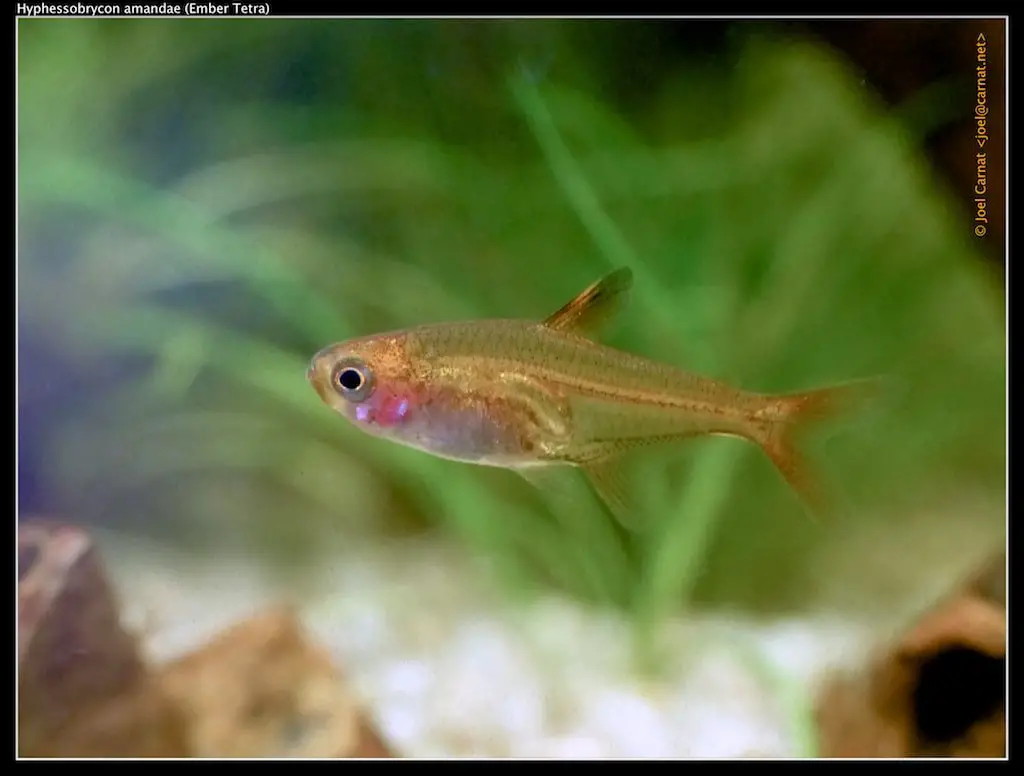
The Ember tetra (Hyphessobrycon amandae) belongs to the Characin family. The ember tetras are native to Brazilian river basins and were first discovered in 1987. The ember tetra was named after the mother of the person who discovered this fish for the first time. These fish have bright orange to reddish coloration throughout their body.
Fish Classification
| Category | Rating |
|---|---|
| Scientific Name | Hyphessobrycon amandae |
| Common Names | Ember Tetra |
| Origin / Habitat | South America, Araguaia River basin |
| Family | Characidae |
| Color Form | Ember Tetra has bright orange to reddish coloration throughout its body. |
| Adult Size | up to 1 inch (2 cm) |
| Lifespan | 2 - 4 years |
| Fish Behavior/Temperament | Peaceful and active. |
| Water Temperature | 75°F - 82°F (24°C - 28°C) |
| Water Hardness | 6° to 11° dH |
| Water pH | 5 - 7 |
| Water Movement | They enjoy the steady current and use them like a treadmill to play. If the water current is too much, it will lead to stress. |
| Lightings | Requires the lights to be on at least 9-11 hours a day. The light watt will depend on factors like aquarium size, amount of substrate, the density of plants. |
| Tank Region | Middle of the tank usually |
| Tankmates | Keep them with similar-sized active fish as they tend to be fin nippers. |
| Diet and Food | Omnivore; accepts any form of food like live food, frozen food, flake food, and pellets. |
| Gender Difference | Male have brighter color and are smaller compared to females. |
| Breeding Difficulties | Substratum egg scatters. |
| Tank Setup | Freshwater[Planted] |
| Disease | Gill Parasites, Swim Bladder Disorder, Furunculosis, Mouth Fungus, Eye-Cloud / Cloudy Eyes, Anchor Worm, Hemorrhagic Septicemia, Fin and Tail Rot, etc. Learn more about:- Tetra Fish Disease and Treatment. |
| Aquarium Size | 10 to 20-gallon minimum recommended (schooling fish) |
27. Emperor Tetra
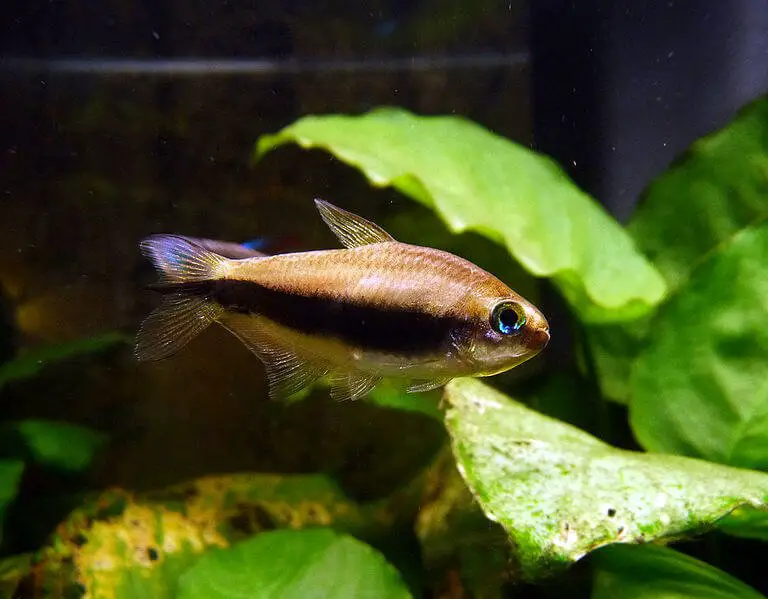
Emperor Tetra, also scientifically known as Nematobrycon Palmeri and commonly known as Emperor Tetra, Imperial Blue Rainbow Tetra, is a species of characid fish found in the Atrato and San Juan river basins in western Colombia.
Below the stripes, the body is lighter in color and the body, the color is blue-gray with mauve tones. A horizontal dark line runs from mouth to tail. Both sexes have yellow hue fins and are edged in black on the outer periphery, and red where the fin meets the body.
The body of Emperor Tetra is long, slim, and gets about 3 inches at maturity. It grows up to 4.2 cm. Emperor tetras are quite easily distinguished from sex. There are several ways to differentiate a male and female emperor tetra; the most reliable method is to observe its eye color. Males will have metallic-blue eyes, whereas females possess metallic-green eyes. Also, the male has a three-pronged tail with the medial black stripe, usually extending beyond the rest of the tail.
The emperor tetra eats both animal and vegetable food. Any good flake or pelleted fish food or any live food like daphnia and mosquito larvae or frozen fish food, including frozen bloodworms, benefits this tetra.
The pH of 6.5 and a temperature of 23–27 °C is the best of the emperor to survive. A pair appears happier than with most tetras.
28. Filigree Blood Fin Tetra

The Filigree Blood Fin tetra (Prionobama filigera) is another beautiful fish from the Characidae family. It is native to the slow-moving waters of Southern America. the Filigree Blood FIn tetra is one of the rarer tetra fish. Its body is long and slender and is transparent. But its caudal fin is red in color giving it a distinctive look and also its name. They grow to about 5cm. The Filigree Blood Fin tetra will look great in a species only tank and your aquarium should hold at least 30 gallons of water.
Fish Classification
| Category | Rating |
|---|---|
| Scientific Name | Prionobama filigera |
| Common Names | Filigree Bloodfin Tetra, or Glass Bloodfin Tetra |
| Origin / Habitat | South America, Amazon Basin |
| Family | Characidae |
| Color Form | Its body is long and slender and is transparent. But its caudal fin is red in color giving it a distinctive look and also its name. |
| Adult Size | average 1½ inches (4 cm) |
| Lifespan | about 5 years |
| Fish Behavior/Temperament | This is a generally peaceful fish and does well when kept in a small school of 6 or more. |
| Water Temperature | 72°F - 80°F (22°C - 27°C) |
| Water Hardness | 6° to 17° dH |
| Water pH | 4 - 8 |
| Water Movement | It prefers a steady low current and not too strong. If there are areas on the aquarium for them to rest against the current, they love the flow. |
| Lightings | Requires the lights to be on at least 9-12 hours a day. Light will aid them in maintaining their circadian rhythm. |
| Tank Region | Middle to Top |
| Tankmates | You can keep them with small and peaceful schooling fish similar to their size. |
| Diet and Food | Omnivore; accepts any form of food like live food, frozen food, flake food, and pellets. |
| Gender Difference | Males are slimmer and small while females are bigger and rounder and may exhibit a larger first anal fin with white beams. |
| Breeding Difficulties | Difficult |
| Tank Setup | Freshwater[Planted] |
| Disease | Fin and Tail Rot, Fish Fungus / Fungal Infection, Ammonia Poisoning, Dropsy, Gill Parasites, Columnaris, Slime Disease, White Spot Disease or ICH, etc. Learn more about:- Tetra Fish Disease and Treatment. |
| Aquarium Size | 30-gallon minimum |
29. Flame Tetra
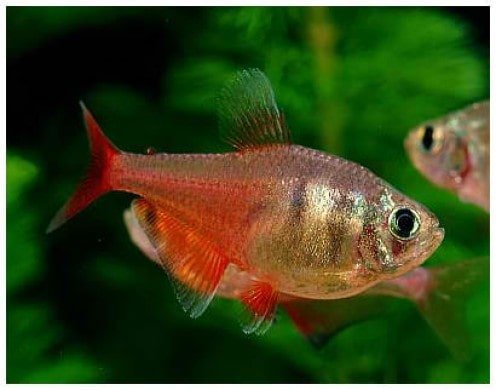
In this case, the name of the fish speaks for itself. These species are some of the most popular tetras in fish keeping hobby due to their size and color. Flame Tetras are community fish and they will light up any community tank with their incredible appearance.
Talking about their body and color, their scales are very thin and transparent (a see through scales) exposing their inner organs. Likewise, their body color is a mix of fire red and orange that looks like a fire (This is where it got its name from). They grow to about 1.2 inches in length and require 20 gallon tank for a school of 6 tetras.
Fish Classification
| Category | Rating |
|---|---|
| Scientific Name | Hyphessobrycon flammeus |
| Common Names | False Neon Tetra |
| Origin / Habitat | Native to Brazil, the vicinity of Rio de Janeiro in the Guanabara Bay region, Paraiba do Sul and Guandu River. |
| Family | Characidae |
| Color Form | The fish has exceptionally vibrant colors of brown and olive-green, gold, sometimes with the yellowish shin. |
| Adult Size | up to 1.5 inch |
| Lifespan | 4 to 5 years, possibly longer |
| Fish Behavior/Temperament | The Green Neon Tetra gets big and needs to be kept with similar-sized species in a large aquarium. |
| Water Temperature | 72°F - 82°F (22°C - 28°C) |
| Water Hardness | 5° to 20° dH |
| Water pH | 6.5 - 7 |
| Water Movement | It prefers a steady current but not too strong. If there are areas on the aquarium for them to rest against the current, they love the flow. |
| Lightings | Due to the fact that these species tend to get frightened easily, they mostly prefer a very low light environment and situations. |
| Tank Region | Middle to upper levels. |
| Tankmates | You can mix them with other types of tetras like neon tetra, black neon tetra, cardinal tetra, glowlight tetra, and many more. |
| Diet and Food | they are omnivorous. They generally eat all kinds of living, fresh, and flake foods. |
| Gender Difference | Difficult to differentiate. |
| Breeding Difficulties | Open water/substratum egg scatters. |
| Tank Setup | Freshwater[Planted] |
| Disease | Slime Disease, Gill Parasites, White Spot Disease or ICH, Fin, and Tail Rot, Velvet, Tumors, Hole In The Head, Anchor Worm, etc. Learn more about:- Tetra Fish Disease and Treatment. |
| Aquarium Size | 10 to 20 gallon |
30. GloFish Tetra
The Glofish tetras are the genetically engineered bright fluorescent fish usually of red, blue, or green color. These fish are injected with GMOs to bring out these artificial colors in the fish. The Glofish tetra is a feat of scientific achievement and will look beautiful in your aquarium tank because of its beautiful and bright colors.
Fish Classification
| Category | Rating |
|---|---|
| Note: GloLight tetra is a genetically modified version of Skirt Tetras[White/Black] so the characteristic of GloLight Tetra is very similar to Black Skirt Tetra | |
| Scientific Name | Gymnocorymbus ternetzi [Black Tetra scientific name] |
| Common Names | GloFish, GloFish tetra |
| Origin / Habitat | South America, river basin areas |
| Family | Characidae |
| Color Form | Genetically engineered bright fluorescent fish usually of red, blue, or green color. |
| Adult Size | 2 inches (6 cm) |
| Lifespan | 4 - 6 years |
| Fish Behavior/Temperament | A generally peaceful little tetra that needs to be in a school of 5 or more. |
| Water Temperature | 72°F-78°F (22 to 26 °C) |
| Water Hardness | 5° to 20° dH |
| Water pH | 6 - 7.5 |
| Water Movement | It prefers a steady current but not too strong. If the water current is too much, it will lead to stress. |
| Lightings | Requires the lights to be on at least 9-10 hours a day. Light will aid them in maintaining their circadian rhythm. |
| Tank Region | All over, but mostly in the middle and top areas of the fish tank. |
| Tankmates | Keep them with similar sized community fish. |
| Diet and Food | The Black Skirt should anything you offer them with. Flakes, frozen, freeze-dried, and may nibble at some aquarium plants. |
| Gender Difference | Females are bigger and has rounded belly as compared to males. |
| Breeding Difficulties | Difficult to breed on captivity. |
| Tank Setup | Freshwater[Planted] |
| Disease | Slime Disease, Eye-Cloud / Cloudy Eyes, Tumors, Dropsy, Hole In The Head, Columnaris, Furunculosis, Pop-Eye, etc. Learn more about:- Tetra Fish Disease and Treatment. |
| Aquarium Size | 30 gallons (114 liters) - a schooling fish and should be kept in groups of 5 or more. |
31. Gold Tetra
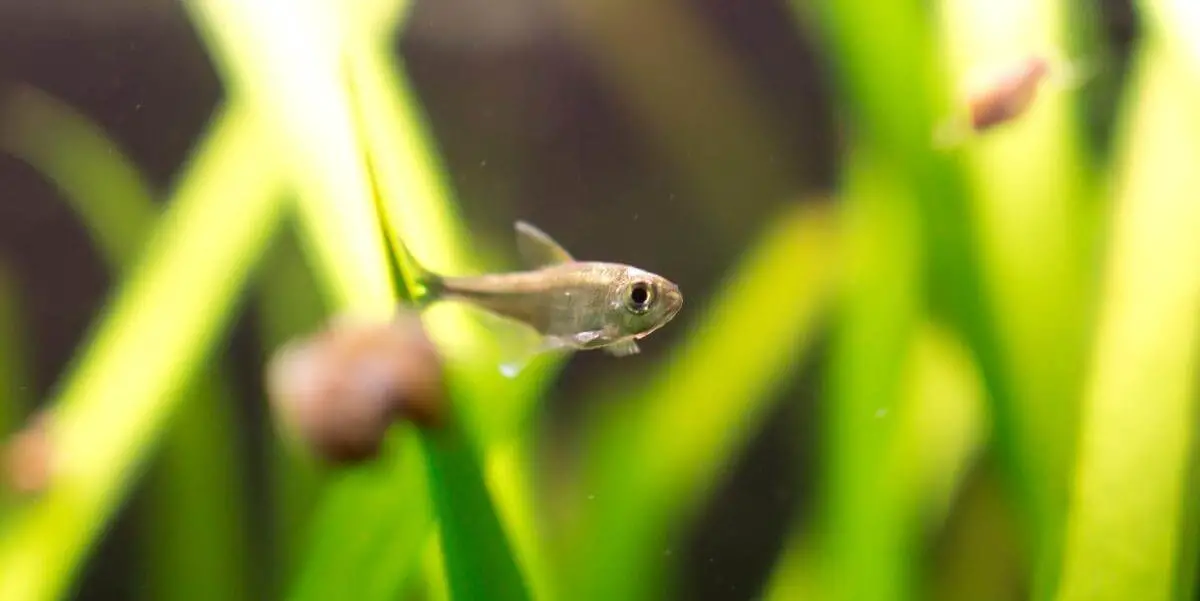
The Gold Tetras (Hemigrammus rodwayi) are small tetra fish. The gold tetra fish are native to South America are some of the fish most attractive tetra fish. The gold coloration throughout the body of Gold tetra makes them stand out among the other fish from the tank. These fish also look great in a community tank with a wide variety of other tetra fish. You can keep a small school of gold tetra easily in a 20-gallon aquarium tank.
Fish Classification
| Category | Rating |
|---|---|
| Scientific Name | Paracheirodon simulans |
| Common Names | False Neon Tetra |
| Origin / Habitat | South America, Upper Negro, and Orinoco River basins |
| Family | Characidae |
| Color Form | The Green Noen Tetra's abdomen and the upper part of their body has a little mix of green shades. Likewise, the signature line in them is not as red and bright as in the neon tetras however has Greenish shared to it too. |
| Adult Size | up to 1 inch (2 cm) |
| Lifespan | 2 to 3 years, possibly longer |
| Fish Behavior/Temperament | The Green Neon Tetra gets big and needs to be kept with similar-sized species in a large aquarium. |
| Water Temperature | 73°F - 80°F (23°C - 27°C) |
| Water Hardness | 6° to 12° dH |
| Water pH | 5.5 - 6 |
| Water Movement | It prefers a steady current but not too strong. If there are areas on the aquarium for them to rest against the current, they love the flow. |
| Lightings | Requires the lights to be on at least 8-11 hours a day. Light will aid them in maintaining their circadian rhythm. |
| Tank Region | Middle to upper levels. |
| Tankmates | It does well when kept in species only tanks or with other small fish species. |
| Diet and Food | Will accept a micro type pellet food (NLS) or smaller flake foods. Supplement with daphnia, thawed brine shrimp, etc. |
| Gender Difference | Difficult to differentiate |
| Breeding Difficulties | Moderate to difficult |
| Tank Setup | Freshwater[Planted] |
| Disease | Slime Disease, Gill Parasites, White Spot Disease or ICH, Fin, and Tail Rot, Velvet, Tumors, Hole In The Head, Anchor Worm, etc. Learn more about:- Tetra Fish Disease and Treatment. |
| Aquarium Size | 10 to 20 gallon (schooling fish) |
32. Glowlight Tetra

The Glowlight Tetra (Hemigrammus erythrozonus) is one of the brightest Tetra fish. It is completely different from the Glofish Tetra and is native to the Guyana river of the Sothern America. They grow to about 6cm. The Glowlight Tetra has a grey body with a bright streak of glowing orange color from its head to its tail. You should at least have a 20 Gallon aquarium for a pair of Flowligt tetra.
Fish Classification
| Category | Rating |
|---|---|
| Scientific Name | Hemigrammus erythrozonus |
| Common Names | Glo-lite Tetra, Glowlight Tetra, Fire Neon Tetra |
| Origin / Habitat | Guyana, South America |
| Family | Characidae |
| Color Form | The Glowlight Tetra has a grey body with a bright streak of glowing orange color from its head to its tail. |
| Adult Size | Up to 1.5 inches (4 cm) |
| Lifespan | 5 years or longer |
| Fish Behavior/Temperament | Peaceful and active |
| Water Temperature | 72°F - 80°F (22°C - 27°C) |
| Water Hardness | 4° to 8° dH |
| Water pH | 5.5 - 7 |
| Water Movement | Keep the water movement moderate. Please don't make the water movement too much to make them continuously swim against. |
| Lightings | Requires the lights to be on at least 11-13 hours a day. For ease by a mechanical/automatic timer switch to remove the manual on-off of lights. |
| Tank Region | Middle to bottom |
| Tankmates | Avoid keeping them with larger fish capable of eating them. They do well with the Neon Tetra and the Black Neon Tetra. |
| Diet and Food | Omnivore; accepts any form of food like live food, frozen food, flake food, and pellets. |
| Gender Difference | It can be difficult to determine, however, females are usually a little larger. |
| Breeding Difficulties | Moderate to Difficult |
| Tank Setup | Freshwater[Planted] |
| Disease | Pop-Eye, Fish Lice, Slime Disease, White Spot Disease or ICH, Anchor Worm, Ammonia Poisoning, Eye-Cloud / Cloudy Eyes, Mouth Fungus, etc. Learn more about:- Tetra Fish Disease and Treatment. |
| Aquarium Size | 20-gallon minimum |
33. Green Neon Tetra
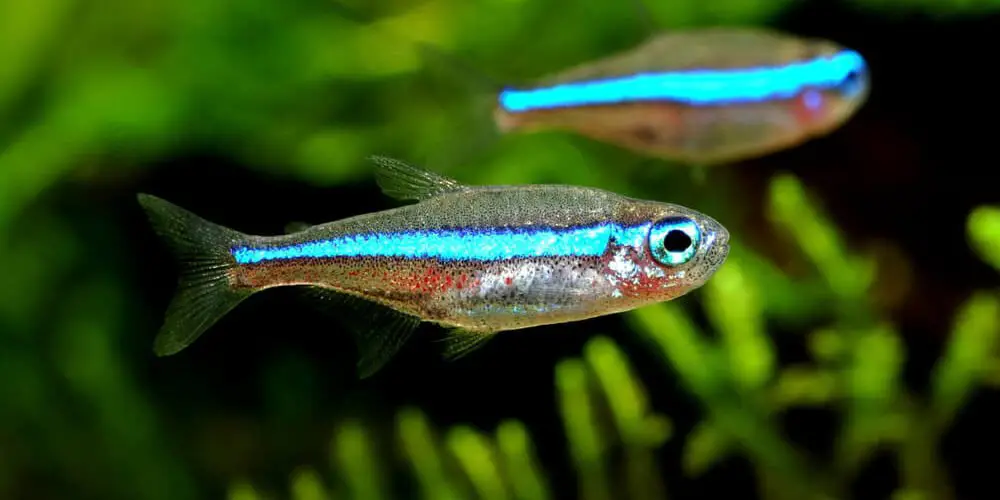
The Green Neon Tetra (Paracheirodon simulans) are small freshwater fish from the Characidae family. They are native to South America’s Orinoco and Negro Rivers. The Green Neon tetra is similar in appearance and is closely related to Neon Tetra but are slightly smaller and slimmer than the neon tetras. It’s easy to differentiate green neon tetra from neon tetra, the difference you will see is the body color. The Green Noen Tetra’s abdomen and the upper part of their body has a little mix of green shades. Likewise, the signature line in them is not as red and bright as in the neon tetras however has Greenish shared to it too. They grow about 3.5 gm (1.4 inches) in length.
Fish Classification
| Category | Rating |
|---|---|
| Scientific Name | Paracheirodon simulans |
| Common Names | False Neon Tetra |
| Origin / Habitat | South America, Upper Negro, and Orinoco River basins |
| Family | Characidae |
| Color Form | The Green Noen Tetra's abdomen and the upper part of their body has a little mix of green shades. Likewise, the signature line in them is not as red and bright as in the neon tetras; however, has Greenish shared with it too. |
| Adult Size | up to 1 inch (2 cm) |
| Lifespan | 2 to 3 years, possibly longer |
| Fish Behavior/Temperament | Peaceful |
| Water Temperature | 73°F - 80°F (23°C - 27°C) |
| Water Hardness | 6° to 12° dH |
| Water pH | 5.5 - 6 |
| Water Movement | It prefers a steady current but not too strong. If there are areas on the aquarium for them to rest against the current, they love the flow. |
| Lightings | Requires the lights to be on at least 8-11 hours a day. Light will aid them in maintaining their circadian rhythm. |
| Tank Region | Middle to upper levels. |
| Tankmates | It does well when kept in species only tanks or with other small fish species. |
| Diet and Food | Will accept a micro type pellet food (NLS) or smaller flake foods. Supplement with daphnia, thawed brine shrimp, etc. |
| Gender Difference | Difficult to differentiate |
| Breeding Difficulties | Open water/substratum egg scatters. |
| Tank Setup | Freshwater[Planted] |
| Disease | Slime Disease, Gill Parasites, White Spot Disease or ICH, Fin, and Tail Rot, Velvet, Tumors, Hole In The Head, Anchor Worm, etc. Learn more about:- Tetra Fish Disease and Treatment. |
| Aquarium Size | 10 to 20 gallon (schooling fish) |
34. Lemon Tetra
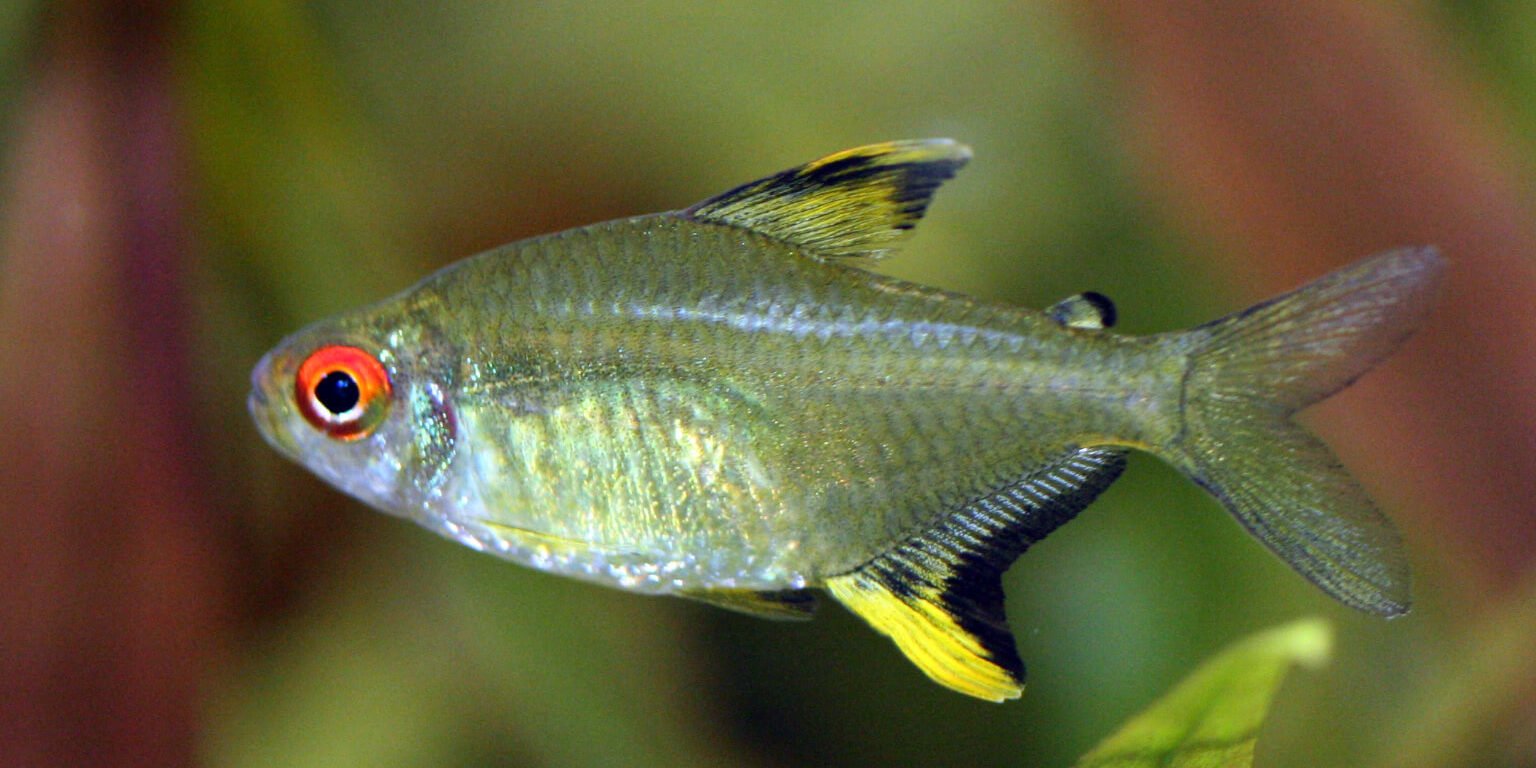
The Lemon Tetras (Hyphessobryeon pulchripinnis) are small tetra fish originating from Southern America. These fish have a white body with a distinct yellow to light yellow coloration around its stomach. The intensity of the color may vary from light yellow to almost bright electric yellow. The lemon tetra was introduced to the fish keeping hobby in the year 1932.
Fish Classification
| Category | Rating |
|---|---|
| Scientific Name | Hyphessobrycon pulchripinnis |
| Common Names | Lemon Tetra |
| Origin / Habitat | Amazon River |
| Family | Characidae |
| Color Form | It has a white body with a distinct yellow to light yellow coloration around its stomach. The intensity of the color may vary from light yellow to almost bright electric yellow. |
| Adult Size | 2 inches (5 cm) |
| Lifespan | 7 to 8 years, even more |
| Fish Behavior/Temperament | Community and peaceful fish |
| Water Temperature | 72°F - 79°F (22°C - 26°C) |
| Water Hardness | 10° to 25° dH, |
| Water pH | 6.0 - 7.5 |
| Water Movement | Keep the water movement moderate. You can tell current is too much if you see your fish laying flat against the aquarium glass. |
| Lightings | Low lightings or enough hiding place if the tank is planted. |
| Tank Region | Middle to bottom |
| Tankmates | Similar sized fish like Danios, Guppies, etc. |
| Diet and Food | Omnivore; accepts any form of food like live food, frozen food, flake food, and pellets. |
| Gender Difference | Hard to differentiate, but the female may be more round in shape. |
| Breeding Difficulties | Lemon Tetras are said fairly easy to spawn. |
| Tank Setup | Freshwater[Planted]. |
| Disease | Dropsy, Gill Parasites, Ammonia Poisoning, Furunculosis, Fish Fungus / Fungal Infection, Velvet, Fish Lice, Pop-Eye, etc. Learn more about:- Tetra Fish Disease and Treatment. |
| Aquarium Size | 15 gallons or larger. |
35. Longfin Tetra
The Longfin tetras (Brycinus longipinnis) are some of the most beautiful tetras form the tetra family. The longfin tetras are native to Africa. And these fish have long dorsal and anal fins. The longfin tetra has rose color in its body. And its fins of the longfin tetra are clear white.
Fish Classification
| Category | Rating |
|---|---|
| Scientific Name | Hyphessobrycon eques |
| Common Names | Jewel Tetra, Red Minor Tetra, Longfin Serpae |
| Origin / Habitat | South America |
| Family | Characidae |
| Color Form | The longfin tetra has rose color in its body. And its fins of the longfin tetra are clear white. |
| Adult Size | 1.5 inches (4 cm) |
| Lifespan | 5 to 8 years |
| Fish Behavior/Temperament | Fin nippers |
| Water Temperature | 72°F - 79°F (22°C - 26°C) |
| Water Hardness | 10° to 25° dH, |
| Water pH | 5 - 7.8 |
| Water Movement | Keep the water movement moderate. You can tell current is too much if you see your fish laying flat against the aquarium glass. |
| Lightings | Requires the lights to be on at least 11-13 hours a day. Light will aid them in maintaining their circadian rhythm. |
| Tank Region | Middle to bottom |
| Tankmates | Other Tetras, Catfish, and Plecos, Swordtails. |
| Diet and Food | Omnivore; accepts any form of food like live food, frozen food, flake food, and pellets. |
| Gender Difference | Difficult to determine. However, female may have more rounded body. |
| Breeding Difficulties | Easy to Moderate. maintain ph between 6.5 and 6.8. |
| Tank Setup | Freshwater[Planted] |
| Disease | Dropsy, Gill Parasites, Ammonia Poisoning, Furunculosis, Fish Fungus / Fungal Infection, Velvet, Fish Lice, Pop-Eye, etc. Learn more about:- Tetra Fish Disease and Treatment. |
| Aquarium Size | 10 gallons or larger. |
36. Mexican Tetra
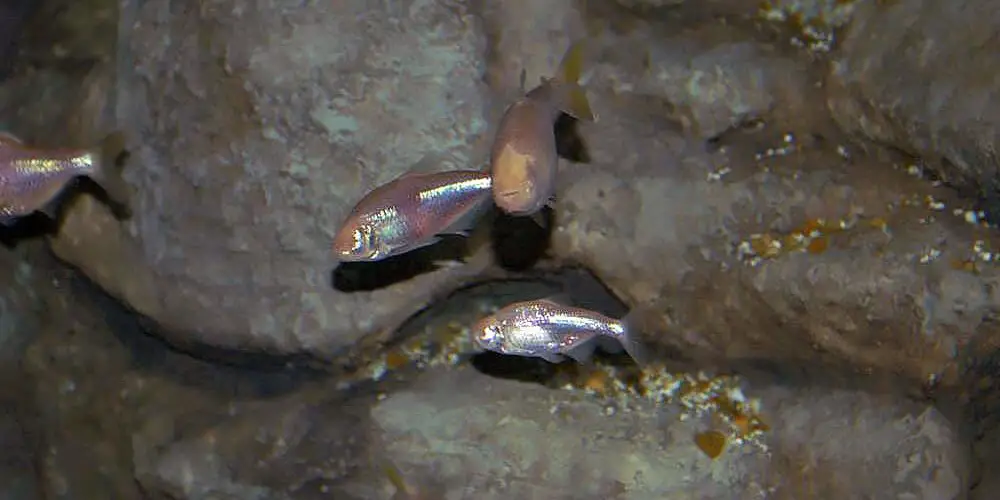
The Mexican tetra (Astyanax mexicanus) is one of the oddball fish from the tetra fish family. These fish were first discovered in a cave from Mexico. We also know the Mexican tetra fish as the blind cave tetras and cave tetras. And like the name suggests they have no eyes. The Mexican tetra fish have an albino body with no eyes. This might be bizarre to most of us fish keepers, but the Mexican tetra has raised a lot of questions to the researchers.
Fish Classification
| Category | Rating |
|---|---|
| Scientific Name | Brycinus longipinnis |
| Common Names | Blind cavefish or blind cave Tetra fish |
| Origin / Habitat | South America, Amazon Basin |
| Family | Characidae |
| Color Form | These fish have pinkish pigmentation with silver linings on their body. |
| Adult Size | Up to 4.6 inches (11 cm) |
| Lifespan | 3-5 years |
| Fish Behavior/Temperament | Aggressive |
| Water Temperature | 61°F - 72°F (16°C - 22°C) |
| Water Hardness | around 30° dH |
| Water pH | 6.5 - 7.5 |
| Water Movement | It prefers a steady current but not too strong. If there are areas on the aquarium for them to rest against the current, they love the flow. |
| Lightings | Dim lighting condition and put some caves to reflect their natural environment. |
| Tank Region | Middle to Top |
| Tankmates | Even though their aggressiveness and nipping habit, they can live in harmony with many other species of fish like Large Tetras, Swordtails, Plecostomus, Corydoras catfish, Silver Dollar, etc. |
| Diet and Food | Omnivore; Will accept a wide variety of food like a worm, insects, live snacks and processed foods for aquarium fishes |
| Gender Difference | Very difficult to identify gender. |
| Breeding Difficulties | Easy to moderate |
| Tank Setup | Freshwater[Planted] |
| Disease | Fin and Tail Rot, Fish Fungus / Fungal Infection, Ammonia Poisoning, Dropsy, Gill Parasites, Columnaris, Slime Disease, White Spot Disease or ICH, etc. Learn more about:- Tetra Fish Disease and Treatment. |
| Aquarium Size | 20-30 gallon minimum |
37. Neon Tetras
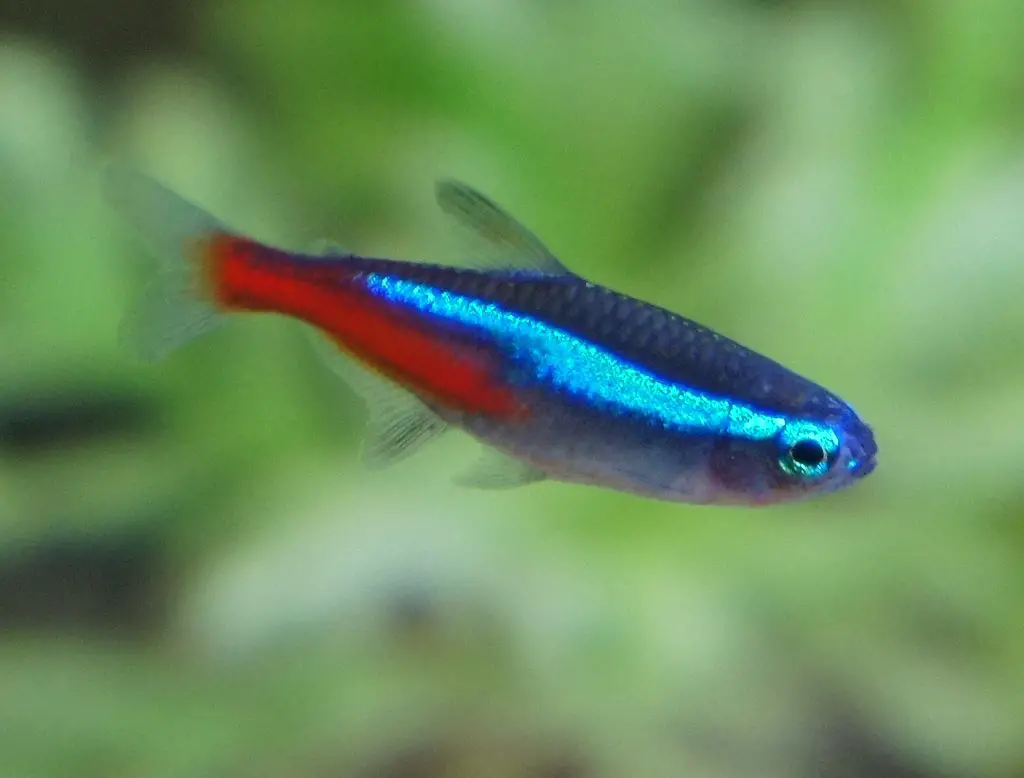
The Neon Tetras (Paracheriodon innesi) are small bright blue tetra fish from the Amazon basin of Cambodia and Peru. These fish have a bright streak of red coloration towards its tail and a bright blue lining in its body. These are the most kept fish from the tetra fish family.
Fish Classification
| Category | Rating |
|---|---|
| Scientific Name | Paracheirodon innesi |
| Common Names | Neon Fish |
| Origin / Habitat | South America - is one of the most imported freshwater fish species. |
| Family | Characidae |
| Color Form | These fish have a bright streak of red coloration towards its tail and a bright blue lining in its body. |
| Adult Size | Up to 1.5 inches (4 cm) |
| Lifespan | 5 - 8 years |
| Fish Behavior/Temperament | Peaceful and active. |
| Water Temperature | 69°F - 79°F (21°C - 26°C) |
| Water Hardness | 1° to 10° dH |
| Water pH | 5 - 7.5 |
| Water Movement | It prefers a steady current but not too strong. If there are areas on the aquarium for them to rest against the current, they love the flow. |
| Lightings | Requires the lights to be on at least 8-11 hours a day. For ease by a mechanical/automatic timer switch to remove the manual on-off of lights. |
| Tank Region | Mostly middle to bottom. |
| Tankmates | Many, given their peaceful nature. Avoid keeping with tropical fish large enough to eat them. |
| Diet and Food | Will go after flakes, live and freeze-dried foods. |
| Gender Difference | The Male is usually smaller than a female of the same age. |
| Breeding Difficulties | They are difficult to breed in the home aquarium. They prefer slightly acidic and soft water around 77 degrees F (source) |
| Tank Setup | Freshwater[Planted] |
| Disease | Hemorrhagic Septicemia, Pop-Eye, Gill Parasites, Fish Fungus / Fungal Infection, Hole In The Head, Columnaris, Furunculosis, Fish Lice, etc. Learn more about:- Tetra Fish Disease and Treatment. |
| Aquarium Size | 10 gallons or larger. |
38. Niger Tetra
The Niger tetra (Arnoldichthys spliopterus) are some of the more rare species of tetra fish which is common in the fish keeping hobby. The niger Tetra is native to Nigeria and it is also known as the African red eye tetra. The body of the niger tetra is dull blue in color but its eye has bright orange to red color. Its odd appearance makes it one of the most sought after tetra fish. These fish can grow up to 10 cm and require at least a 30gallon aquarium.
Fish Classification
| Category | Rating |
|---|---|
| Scientific Name | Arnoldichthys spilopterus |
| Common Names | African red-eyed Tetra, Niger tetra |
| Origin / Habitat | Nigeria |
| Family | Characidae |
| Color Form | The body of the niger tetra is dull blue in color, but its eye has bright orange to red color. Its odd appearance makes it one of the most sought after tetra fish. |
| Adult Size | Up to 4 inches (10 cm) |
| Lifespan | 5 - 8 years |
| Fish Behavior/Temperament | Peaceful and active |
| Water Temperature | 75°F - 82°F (24°C - 27°C) |
| Water Hardness | around 5°-19° dH |
| Water pH | 6.5 - 8 |
| Water Movement | It prefers a steady current but not too strong. If there are areas on the aquarium for them to rest against the current, they love the flow. |
| Lightings | Prefers dim light. None when breeding |
| Tank Region | Mostly middle to the top. |
| Tankmates | Similar sized non-aggressive active fish. |
| Diet and Food | Unfussy eater; will take most foods. |
| Gender Difference | the sexes are almost identical. However, can be differentiated looking at the anal fin. Anal fin in the female have a translucent appearance with a black spot on rays beneath adipose fin, while in males the anal fin is lemon yellow |
| Breeding Difficulties | Fairly easy to get to spawn in the aquarium and if in good condition |
| Tank Setup | Freshwater[Planted] |
| Disease | Hemorrhagic Septicemia, Pop-Eye, Gill Parasites, Fish Fungus / Fungal Infection, Hole In The Head, Columnaris, Furunculosis, Fish Lice, etc. Learn more about:- Tetra Fish Disease and Treatment. |
| Aquarium Size | 30-50 gallons or larger. |
39. Penguin Tetra (Hockey stick)

The Penguin Tetra (Thayeria boehlkei) is one of the most beautiful tetra fish. We also know the penguin tetras as the hokey stick tetra. The hokey sick tetras are some of the easiest to keep in a school. Their body is light gray in color and has a straight streak of a line that ends in the bottom part of the tail fin of the fish. This streak gives a distinct look of a hockey stick so it is known as hokey stick tetra.
Fish Classification
| Category | Rating |
|---|---|
| Scientific Name | Thayeria boehlkei |
| Common Names | Blackline Penguinfish, Hockey Stick Tetra, Penguinfish |
| Origin / Habitat | South America, upper Amazon River basin in Peru and Araguaia River in Brazil. |
| Family | Characidae |
| Color Form | Their body is light gray in color and has a straight streak of a line that ends in the bottom part of the tail fin of the fish. This streak gives a distinct look of a hockey stick, so it is known as hokey stick tetra. |
| Adult Size | 1.2 inches (3 cm) |
| Lifespan | 3 - 5 years |
| Fish Behavior/Temperament | Very similar to other tetras. Keep them in groups of 5 or more. |
| Water Temperature | 72°F - 82°F (22°C - 28°C) |
| Water Hardness | 5-20 |
| Water pH | Water parameters: 6 - 8 |
| Water Movement | Keep the water movement moderate. If there are areas on the aquarium for them to rest against the current, they love the flow. |
| Lightings | Requires the lights to be on at least 8-9 hours a day. Light will aid them in maintaining their circadian rhythm. |
| Tank Region | Middle to upper regions of the aquarium. |
| Tankmates | Keep them in groups and don't keep them with fish large enough to eat them. |
| Diet and Food | Small worms, insects, crustaceans in the small streams where they originate. They will go after smaller pellet foods and flake foods. You can also feed them blood worms, brine shrimp, and other freshwater foods. |
| Gender Difference | They don't have any external characteristics to determine males and females. |
| Breeding Difficulties | Difficult to breed in captivity |
| Tank Setup | Freshwater[Planted] |
| Disease | Fish Lice, Velvet, Columnaris, Swim Bladder Disorder, Hemorrhagic Septicemia, Gill Parasites, Furunculosis, Tumors, etc. Learn more about:- Tetra Fish Disease and Treatment. |
| Aquarium Size | 20 to 30 gallon recommended (schooling fish) |
40. Rainbow Tetra
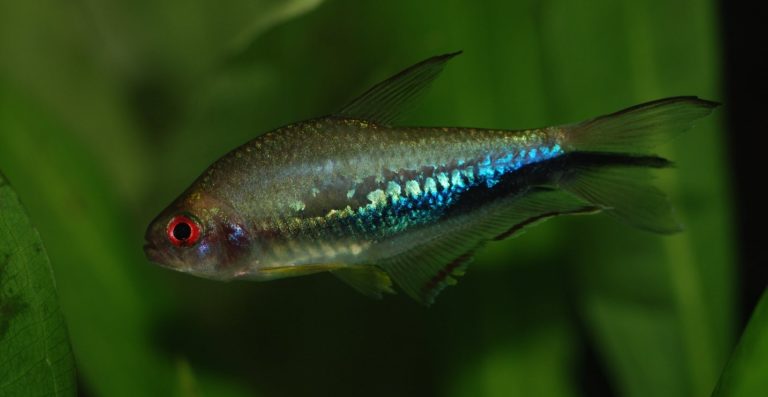
Rainbow tetra are one of the most demanding Tetra species in the world. Rainbow Tetra is a peaceful species of fish and rare in type usually found in sluggish tributaries, small quiet rivers.
Rainbow tetra originates from South America and is precinct to Western Colombia. Rainbow Tetra is a peaceful shoaling species mostly found in a small quiet river(Rio Calima) and a stream of the Rio San Juan basin.
Rainbow Tetra belongs to the Characidae family. It has many of the same traits as the Emperor Tetra. Usually, the size of the fish in captivity is 3-4cm (1.18 – 1.57 inch).
Fish Classification
| Category | Rating |
|---|---|
| Scientific Name | Nematobrycon lacortei |
| Common Names | Rainbow Tetra |
| Origin / Habitat | South America, Atrato and San Juan River basins. |
| Family | Characidae |
| Color Form | They have a beautiful multicolor, blue, and red being the dominant color. |
| Adult Size | 1.5 inches (4.2 cm) |
| Lifespan | 3 - 5 years |
| Fish Behavior/Temperament | Semi-aggressive |
| Water Temperature | 72°F - 80°F (22°C - 27°C) |
| Water Hardness | 5° to 8° DH |
| Water pH | Water parameters: 5 - 8.0 |
| Water Movement | Keep the water movement moderate. Please don't make the water movement too much to make them continuously swim against. |
| Lightings | Requires the lights to be on at least 9-10 hours a day. Light will aid them in maintaining their circadian rhythm. |
| Tank Region | Middle to bottom can be quite active |
| Tankmates | Semi aggressive and avoid fish with long fins to avoid fin nipping. |
| Diet and Food | Omnivore; accepts any form of food like live food, frozen food, flake food, and pellets. |
| Gender Difference | Males have blue eyes, and females have green eyes. |
| Breeding Difficulties | Substratum egg scatters. Reported to spawn more frequently in heavily planted aquariums on the slightly acidic side. Remove the eggs, so the parents don't eat them. |
| Tank Setup | Freshwater[Planted] |
| Disease | Fish Lice, Tumors, Furunculosis, Fin and Tail Rot, Hole In The Head, Swim Bladder Disorder, White Spot Disease or ICH, Eye-Cloud / Cloudy Eyes, etc. Learn more about:- Tetra Fish Disease and Treatment. |
| Aquarium Size | 20 to 30 gallon recommended (schooling fish) |
41. Red Blue Colombian tetra
The Red Blue Colombian tetras (Hyphessobrycon columbianus) are some of the best looking tetra fish in my opinion. The Red blue Colombian tetras are native to northwestern Colombia. They have bright blue colors in their body and distinct red fins which gives them their name red blue Colombian tetra.
42. Red-Eye Tetra
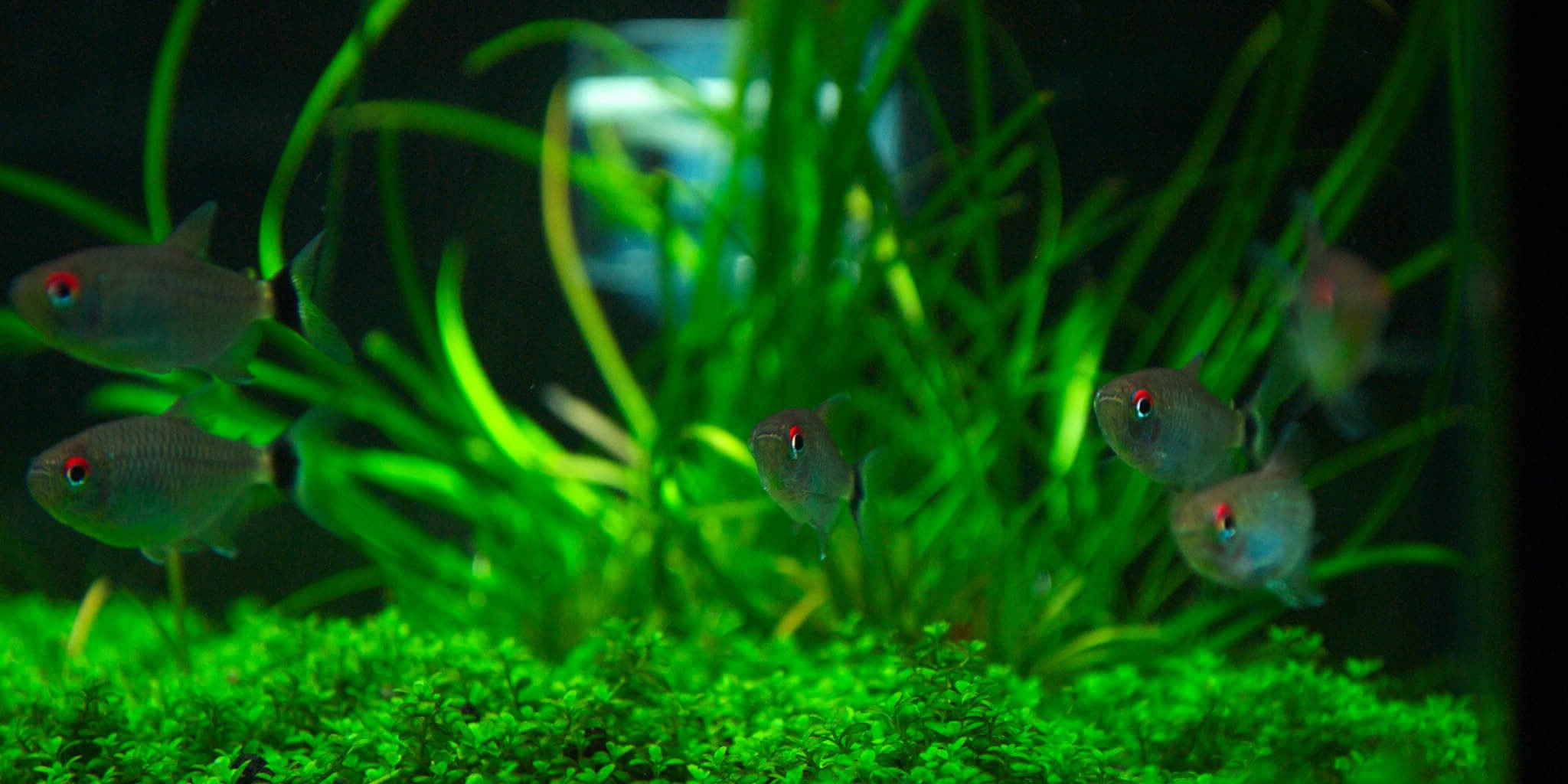
Red-Eye Tetra (Scientific Name: Moenkhausia sanctaefilomenae) was first described in the year 1907. The fish is an excellent choice for aquarists new to the hobby. This type of Tetra is very peaceful in nature and is compatible with other non-aggressive fish. Red-eye tetra usually is bright silver in color, a thin red circle around its eye, and a white-edged black basal half of the tail.
Scientifically, it is also called Moenkhausia sanctaefilomenae. Red-eye tetra is a species of tetra from the São Francisco, upper Paraná, Paraguay, and river basins in eastern and central South America. In Eastern Europe and Asia, this freshwater fish is commonly kept in aquariums and bred in large numbers at commercial facilities. Its maximum size can be 7 cm in length and lifespan for approximately five years.
Red-eye tetra is a hardy fish; the fish can tolerate a range of water conditions but prefer slightly soft, acid water. They add an elegant touch to the larger freshwater aquarium. The water volume of about 110 liters or 29 Gallons is recommended. The fish needs temperatures of 72–79 °F in a planted tank with plenty of shoaling space.
Generally, in the aquarium red-eye, tetra eats all kinds of live, fresh, and high-quality flake food to keep the right balance every day with brine shrimp (either live or frozen) or blood worms as a treat.
Males have smaller and flat abdomen while females Red tetras are larger and have a more rounded abdomen than the male tetras.
To breed red eye tetra, a separate breeding tank is required with slightly acidic, very soft water (4 dGH or below).
The Red-eye tetra lay eggs among the roots of floating plants and is free spawning. Once spawning has occurred, the mating pair should be removed, as they will consume the eggs and hatching fry. It takes only one day to hatch the eggs after they are laid.
Fish Classification
| Category | Rating |
|---|---|
| Scientific Name | Moenkhausia sanctaefilomenae |
| Common Names | Yellowhead Characin, Yellowhead Tetra, Yellow-banded moenkhausia |
| Origin / Habitat | South America, Brazil, River Basin areas |
| Family | Characidae |
| Color Form | Red-eye Tetra usually is bright silver in color, a thin red circle around its eye, and a white-edged black basal half of the tail. |
| Adult Size | 3 inches (7 cm) |
| Lifespan | 3 - 5 years |
| Fish Behavior/Temperament | A very peaceful tetra that needs to be in a school of 5 or more. |
| Water Temperature | 75°F - 80°F (24°C - 27°C) |
| Water Hardness | 5° to 20° dH |
| Water pH | 6 - 7.5 |
| Water Movement | It prefers a steady current but not too strong. You can tell current is too much if you see your fish laying flat against the aquarium glass. |
| Lightings | Requires the lights to be on at least 10-11 hours a day. For ease by a mechanical/automatic timer switch to remove the manual on-off of lights. |
| Tank Region | All over the tank. |
| Tankmates | You don't want to keep them with more boisterous or overly aggressive tank mates. They may nip fins if kept solitary. |
| Diet and Food | The Red Eye Tetra should eat the most common aquarium foods. Flakes, frozen, freeze-dried, and may nibble at some aquarium plants. |
| Gender Difference | May be able to tell the difference in males and females when the female gets "fatter" or fuller. |
| Breeding Difficulties | They will scatter their eggs on the substrate. The adults may eat the eggs. |
| Tank Setup | Freshwater[Planted] |
| Disease | Mouth Fungus, Pop-Eye, Slime Disease, Dropsy, Hemorrhagic Septicemia, Tumors, Velvet, Columnaris, etc. Learn more about:- Tetra Fish Disease and Treatment. |
| Aquarium Size | 30-gallon tank (114 liters) - this is a schooling fish and should be kept in groups of 5 or more. |
43. Rosy Tetra
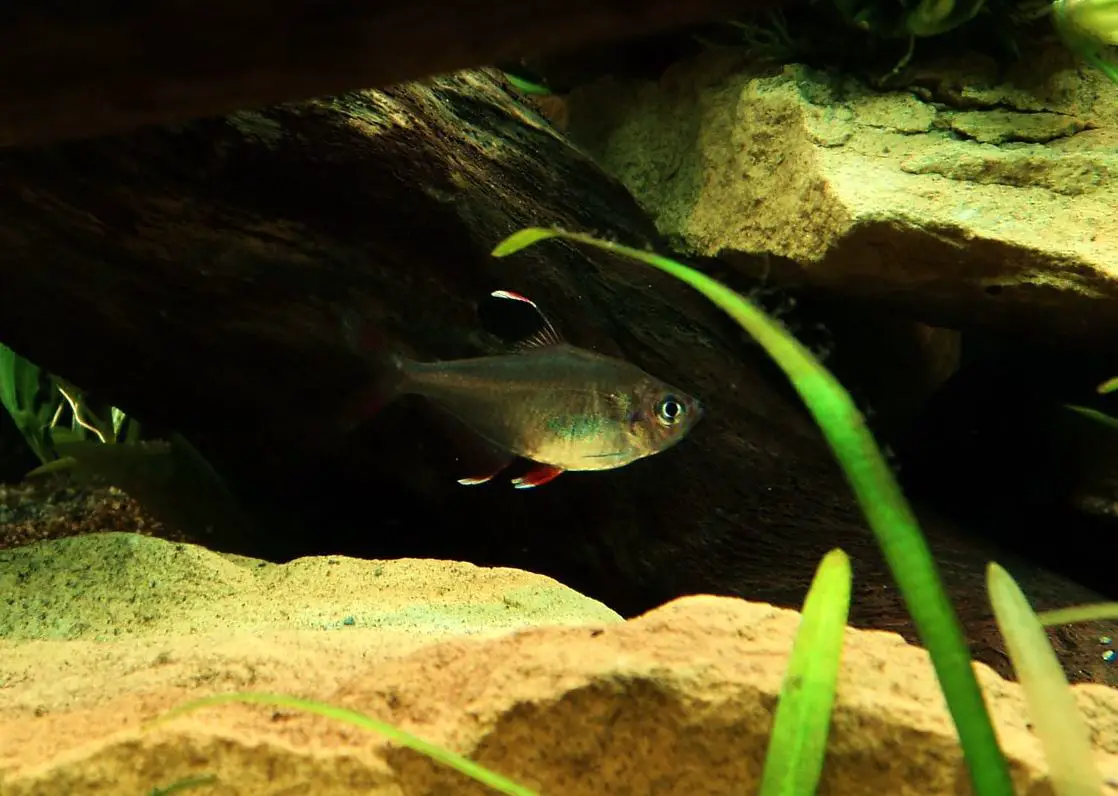
The Rosy Tetra (Hyphessobrycon rosaceus) is a small tetra fish that grows to about 3inches in size. The rosy tetra is native to Brazil and Guyana. Their body has a very light red and orange color. These fish are slightly larger than the normal tetra fish and do take up quite a space in your aquarium tank.
Fish Classification
| Category | Rating |
|---|---|
| Scientific Name | Hyphessobrycon rosaceus |
| Common Names | Rosy Tetra |
| Origin / Habitat | South America, Amazon River. Rio Negro floodplain, central Amazonia |
| Family | Characidae |
| Color Form | Its body has a very light red and orange color. |
| Adult Size | ½ inches (4 cm) |
| Lifespan | Maximum 3 to 5 years (if cared properly) |
| Fish Behavior/Temperament | Peaceful |
| Water Temperature | 75°F - 82°F (24°C - 28°C) |
| Water Hardness | 4° to 12° dH |
| Water pH | 5.5 - 7.5 |
| Water Movement | Moderate; if the water current is too much, it will lead to stress. |
| Lightings | Moderate – normal lighting |
| Tank Region | Middle |
| Tankmates | A very peaceful fish that's best kept in a small school. Try not to keep them with aggressive fish or fish large enough to eat them, such as angelfish and Silver Dollar. Often kept with Discus. |
| Diet and Food | Omnivorous, they can eat both plants and live food. In the wild, they eat live insects, worm, and other plants matter. In captivity, they are quite unfussy and will accept good quality food. |
| Gender Difference | Males have a longer and more pointed dorsal fin |
| Breeding Difficulties | Moderate. |
| Tank Setup | Freshwater[Planted] |
| Disease | Fish Fungus / Fungal Infection, Mouth Fungus, Pop-Eye, Fish Lice, White Spot Disease or ICH, Furunculosis, Fin and Tail Rot, Swim Bladder Disorder, etc. Learn more about:- Tetra Fish Disease and Treatment. |
| Aquarium Size | 15-gallon minimum |
44. Ruby Tetra
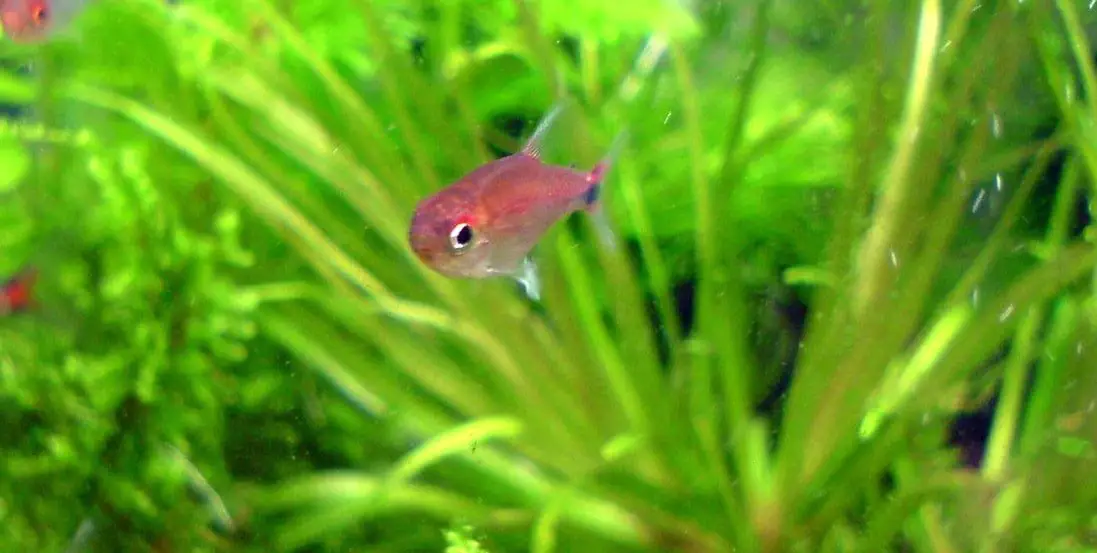
Ruby Tetra, freshwater subtropical characin, is a small genus of Tetra which stands out in any aquarium with its beautiful appearance.
Dating back to its discovery in 1988, this Tetra is an inhabitant of leaf litter and floating plants with clean yet acidic water rich in tannins. It originated from the upper Río Meta, Colombia, South America.
Ruby Tetra are peaceful and shoaling species rather than most schooling Tetras. However, they are territorial in nature. This is what makes them shoaling rather than a schooling species.
Ruby Tetra are comparatively smaller in size and can grow up to 1.6 inches (4 cm) approximately.
Fish Classification
| Category | Rating |
|---|---|
| Scientific Name | Axelrodia riesei |
| Common Names | Ruby Tetra |
| Origin / Habitat | It originated from the upper Río Meta, Colombia, South America. |
| Family | Characidae |
| Color Form | Ruby Tetra can be distinguished by its small ruby red tinted body, transparent fins, and a black spot at the end of its tail. |
| Adult Size | 1.6 inches (4 cm) approximately. |
| Lifespan | 5 - 10 years |
| Fish Behavior/Temperament | Community and peaceful fish |
| Water Temperature | 68° – 82.4° F (20° – 28° C) |
| Water Hardness | 3° to 12° dH |
| Water pH | 5.0-7.0, slightly acidic water |
| Water Movement | They enjoy the steady current and use them like a treadmill to play. If the water current is too much, it will lead to stress. |
| Lightings | Since the natural habitat of Ruby Tetra is in the presence of leaf litter and floating plants, they require moderate lighting. They tend to do well in a shaded environment with dim lights. |
| Tank Region | Middle to bottom |
| Tankmates | Similar sized fish like Platys, Corydoras Catfish, Honey Gouramis, Guppies, etc. |
| Diet and Food | Omnivorous, Micropredator |
| Gender Difference | The males tend to be rather smaller and brighter while the females are rounder and bigger. |
| Breeding Difficulties | It is comparatively hard to breed due to its delicate nature. |
| Tank Setup | Freshwater[Planted] |
| Disease | Fish Fungus / Fungal Infection, Mouth Fungus, Pop-Eye, Fish Lice, White Spot Disease or ICH, Furunculosis, Fin and Tail Rot, Swim Bladder Disorder, etc. Learn more about:- Tetra Fish Disease and Treatment. |
| Aquarium Size | 10-gallon minimum (keep in small schools) |
45. Rummy nose Tetra
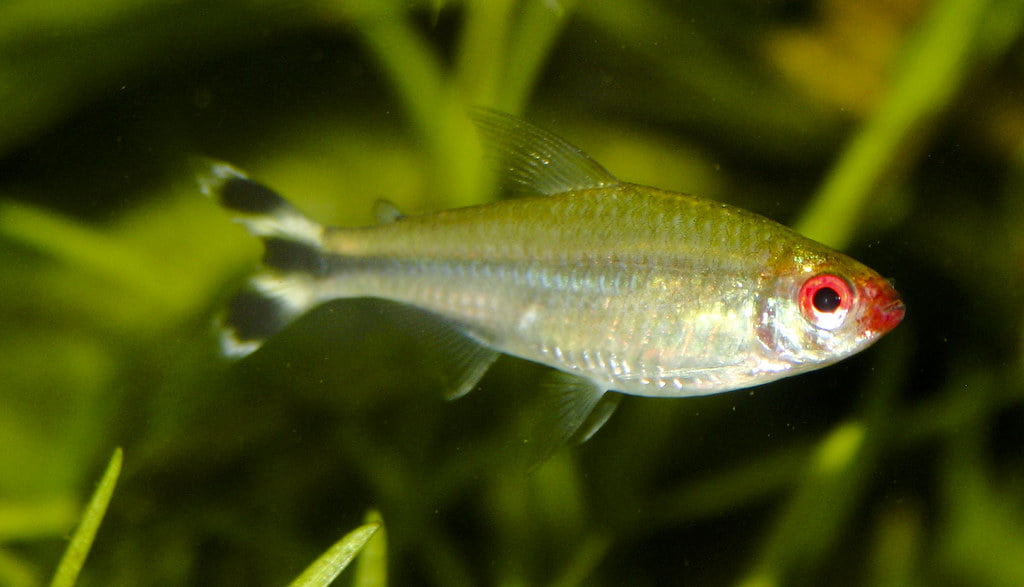
The Rummy nose tetras (Hemigrammus rhodostomus) are another interesting looking fish from the tetra variety. These fish have a distinct red-colored head and a plain white body. This color makes the fish look as if it is bleeding from its nose. The rummy nose tetras are some of the most popular tetra fish because of its unique appearance.
Fish Classification
| Category | Rating |
|---|---|
| Scientific Name | Hemigrammus bleheri |
| Common Names | Brilliant Rummy Nose Tetra, Firehead Tetra, Red Nose Tetra |
| Origin / Habitat | South America, Amazon River. Rio Negro floodplain, central Amazonia |
| Family | Characidae |
| Color Form | These fish have a distinct red-colored head and a plain white body. This color makes the fish look as if it is bleeding from its nose. |
| Adult Size | 2 inches (5 cm) |
| Lifespan | 3 - 5 years |
| Fish Behavior/Temperament | Very peaceful. |
| Water Temperature | 72°F - 80°F (22°C - 27°C) |
| Water Hardness | 4° to 11° dH |
| Water pH | 5.5 - 7.0 |
| Water Movement | They enjoy the steady current and use them like a treadmill to play. If the water current is too much, it will lead to stress. |
| Lightings | Requires the lights to be on at least 10-12 hours a day. The light watt will depend on factors like aquarium size, amount of substrate, the density of plants. |
| Tank Region | Middle to bottom |
| Tankmates | Peaceful and active community fish. |
| Diet and Food | Omnivore; accepts any form of food like live food, frozen food, flake food, and pellets. |
| Gender Difference | Difficult to determine |
| Breeding Difficulties | Difficult. They require water on the acidic side of the scale. |
| Tank Setup | Freshwater[Planted] |
| Disease | Fish Fungus / Fungal Infection, Mouth Fungus, Pop-Eye, Fish Lice, White Spot Disease or ICH, Furunculosis, Fin and Tail Rot, Swim Bladder Disorder, etc. Learn more about:- Tetra Fish Disease and Treatment. |
| Aquarium Size | 20-gallon minimum (keep in small schools) |
46. Serpae Tetra
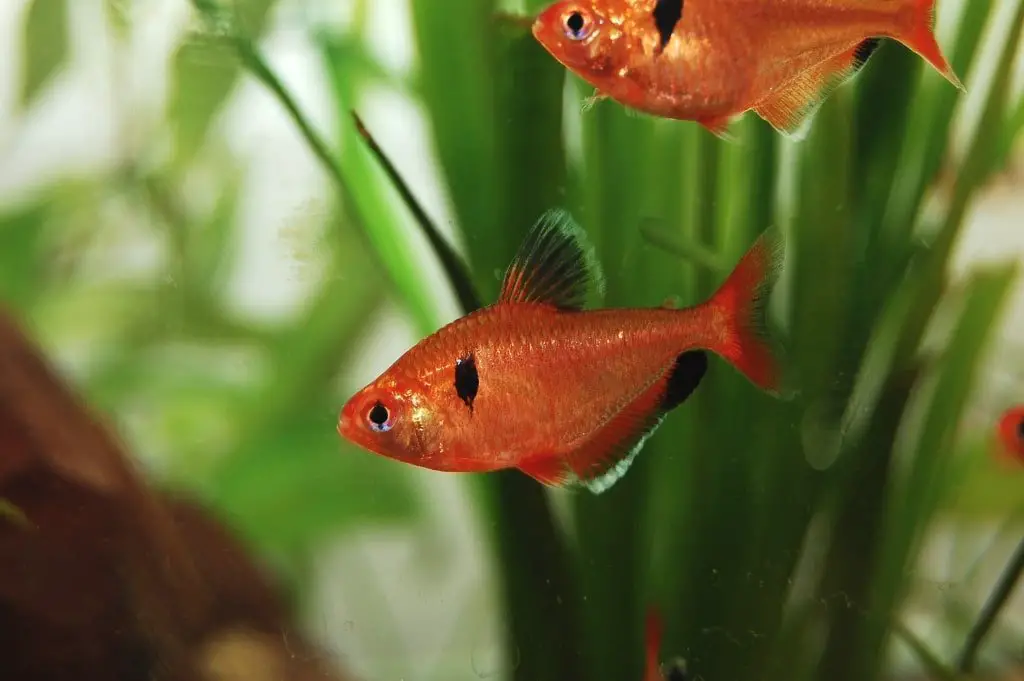
The Serape tetras (Hyphessobrycon eques) are small fire-colored tetra fish. We also know the Serpae tetras as jewel tetras. The jewel tetras are native to the Amazon basin of Peru and Cambodia. It has an orange body with bright orange colored fins. The dorsal fin of the Serpae tetras are black and it also has a black marking behind its gills. Serpae tetras grown to about 4 inches and are the perfect fish for any community tank due to its bright orange colors.
Fish Classification
| Category | Rating |
|---|---|
| Scientific Name | Hyphessobrycon eques |
| Common Names | Jewel Tetra, Red Minor Tetra, Longfin Serpae |
| Origin / Habitat | South America |
| Family | Characidae |
| Color Form | The longfin tetra has rose color in its body. And its fins of the longfin tetra are clear white. |
| Adult Size | 1.5 inches (4 cm) |
| Lifespan | 5 to 8 years |
| Fish Behavior/Temperament | Fin nippers |
| Water Temperature | 72°F - 79°F (22°C - 26°C) |
| Water Hardness | 10° to 25° dH, |
| Water pH | 5 - 7.8 |
| Water Movement | Keep the water movement moderate. You can tell current is too much if you see your fish laying flat against the aquarium glass. |
| Lightings | Requires the lights to be on at least 11-13 hours a day. Light will aid them in maintaining their circadian rhythm. |
| Tank Region | Middle to bottom |
| Tankmates | Other Tetras, Catfish, and Plecos, Swordtails. |
| Diet and Food | Omnivore; accepts any form of food like live food, frozen food, flake food, and pellets. |
| Gender Difference | Difficult to determine. However, female may have more rounded body. |
| Breeding Difficulties | Easy to Moderate. maintain ph between 6.5 and 6.8. |
| Tank Setup | Freshwater[Planted] |
| Disease | Dropsy, Gill Parasites, Ammonia Poisoning, Furunculosis, Fish Fungus / Fungal Infection, Velvet, Fish Lice, Pop-Eye, etc. Learn more about:- Tetra Fish Disease and Treatment. |
| Aquarium Size | 10 gallons or larger. |
47. Silvertip Tetra
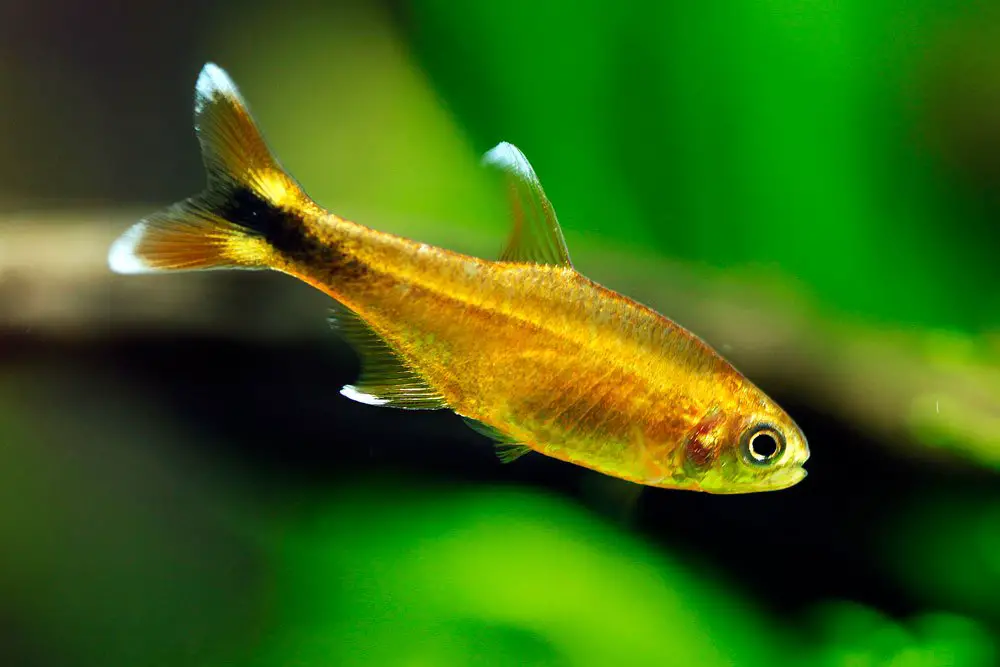
Silvertip tetra (Hasemania nana) is a small tetra fish that is slightly more aggressive. They are native to small creeks of Brazil. The silvertip tetras have yellow to almost golden body color. And the tip of the tail and anal fins are bright white or silver. And for these reasons, this fish is known as Silvertip Tetra.
Fish Classification
| Category | Rating |
|---|---|
| Scientific Name | Hasemania nana |
| Common Names | Silvertip tetra |
| Origin / Habitat | Silvertip Tetra originates from South America and Sao Francisco in Brazil. |
| Family | Characidae |
| Color Form | The silvertip tetras have yellow to almost golden body color. And the tip of the tail and anal fins are bright white or silver. |
| Adult Size | 2 inches (5 cm), sometimes slightly larger. |
| Lifespan | 5 to 8 years (if cared properly) |
| Fish Behavior/Temperament | Peaceful and Active |
| Water Temperature | 22 - 28°C (72 - 82°F) |
| Water Hardness | 5° to 12° dH |
| Water pH | 6 - 7.5 |
| Water Movement | Keep the water movement moderate. Please don't make the water movement too much to make them continuously swim against. |
| Lightings | Dim lighting will be best for your Tetra. Even though your aquarium looks a little bit dark due to the dim lighting, you can easily see the Silvertip Tetra because of their shining body that looks stunning in the aquarium when they reflect the light. |
| Tank Region | All levels |
| Tankmates | You don't want to keep them overly aggressive tank mates. |
| Diet and Food | Omnivores (can eat both plant and live food). |
| Gender Difference | Male silvertip tetras have a coppery color while females are grey. |
| Breeding Difficulties | Moderate. Silvertip tetras like most other tetras are egg scatterers. The Malemale chases the female, and during the chase, the eggs are laid and fertilized over fine-leaved plants. |
| Tank Setup | Freshwater[Planted] |
| Disease | Fin and Tail Rot, Tumors, Slime Disease, Anchor Worm, Columnaris, Gill Parasites, Mouth Fungus, Eye-Cloud / Cloudy Eyes, etc. Learn more about:- Tetra Fish Disease and Treatment. |
| Aquarium Size | 15-20 gallons - remember, this is a schooling fish. |
48. X-Ray Tetra
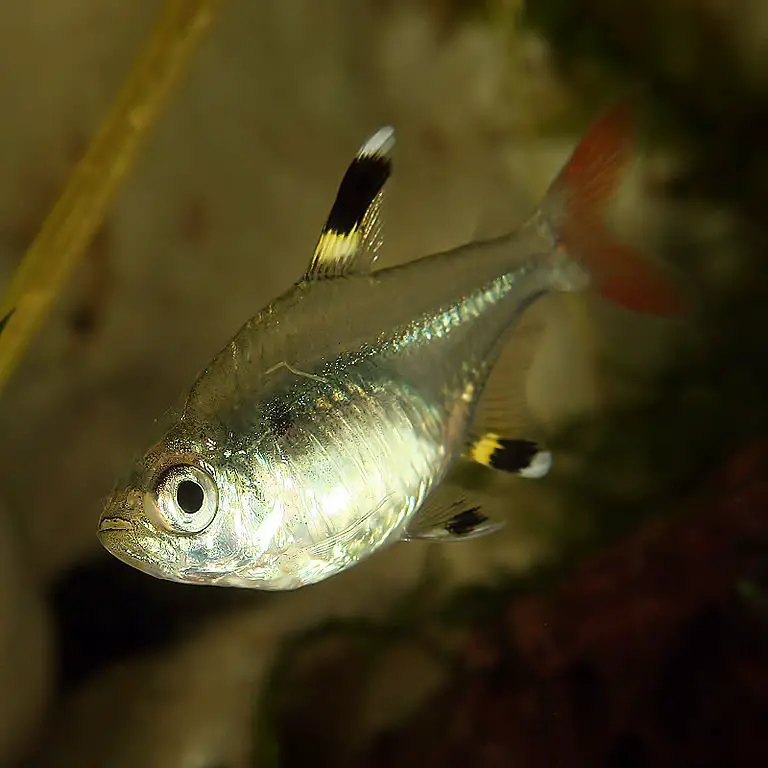
The X-Ray Tetra (Pristella maxillaris) is a unique looking fish from the Characin family. It has a complete see-through body except for its abdomen and head. The X-Ray tetras are native to Venezuela, Brazil, Suriname, Guyana, French Guiana, and other parts of Southern America. These fish are very small in size and only grows to about 4cm. you can keep the X-Ray tetra in a biotope tank where it will thrive the most. The appearance of the X-Ray Tetra is very unorthodox so many breeders have been breeding X-Ray tetras in captivity to produce thousands of fish to meet the increasing demands of the costumers. As of now, there are two varieties of X-Ray tetra, one being the normal X-Ray tetra with clear white transparent body and the other is a Gold colored variant of the same fish.
Fish Classification
| Category | Rating |
|---|---|
| Scientific Name | Pristella maxillaris |
| Common Names | X-Ray Tetra, Pristella Tetra, Albino Pristella |
| Origin / Habitat | Amazon River, South America |
| Family | Characidae |
| Color Form | There are two varieties of X-Ray tetra, one being the normal X-Ray tetra with a clear white transparent body, and the other is a Gold colored variant of the same fish. |
| Adult Size | 2 inches (5 cm) |
| Lifespan | 5 years or longer |
| Fish Behavior/Temperament | This is a schooling fish that is usually very peaceful. It is listed as a non-invasive species. |
| Water Temperature | 75°F - 82°F (24°C - 28°C) |
| Water Hardness | 4° to 11° dH |
| Water pH | 6 - 8 |
| Water Movement | They enjoy the steady current and use them like a treadmill to play. If the water current is too much, it will lead to stress. |
| Lightings | Requires the lights to be on at least 9-10 hours a day. The light watt will depend on factors like aquarium size, amount of substrate, the density of plants. |
| Tank Region | Middle to bottom |
| Tankmates | They are generally peaceful but may be skittish around larger tank mates. Best kept in a small school of 6 or more. |
| Diet and Food | Omnivore; accepts any form of food like live food, frozen food, flake food, and pellets. |
| Gender Difference | Difficult to determine. |
| Breeding Difficulties | Moderate to difficult. |
| Tank Setup | Freshwater[Planted] |
| Disease | White Spot Disease or ICH, Eye-Cloud / Cloudy Eyes, Slime Disease, Columnaris, Fish Fungus / Fungal Infection, Tumors, Dropsy, Fin and Tail Rot, etc. Learn more about:- Tetra Fish Disease and Treatment. |
| Aquarium Size | 10-gallon minimum (schooling fish) |
Conclusion
These are some of the most kept tetra fish in the fish keeping hobby. The tetra fish are very easy to keep and have a vast personality. Tetra fish come in various colors and patterns. You will find out one for any type of aquarium tank that you have. The arrays of colors of tetra fish will give you a ton of choices to choose from.
There is a lot of new tetra fish being discovered and added to the large list of tetra fish family. New varieties of Tetra fish are added every year in the already large family of tetra fish.